Environmental Review no. 6 2007
Waste Statistics 2005
Contents
1 Waste generation and treatment
- 1.1 Waste generation 2005 and developments 2004-2005
- 1.2 Waste management in 2005
- 1.3 Treatment of waste without residues and construction and demolition waste
- 1.4 Treatment by source and waste type
- 1.5 Developments in waste generation 1994-2005
- 2.1 Recycling by fraction
- 2.2 Paper and cardboard
- 2.3 Plastic
- 2.4 Bottles and glass
- 2.5 Ferrous metal
- 2.6 Organic waste for composting, wood chipping and biogasification
- 2.7 Tyres
4 Imports and exports of waste
- 4.1 Imports
- 4.2 Exports
- 4.3 Imports and exports of waste subject to mandatory notification
- 4.4 OECD codes
5 Individual waste sources and status in relation to targets for 2008
- 5.1 Waste from households
- 5.2 Waste from the service sector
- 5.3 Waste from industry
- 5.4 Waste from building and construction activities
- 5.5 Residues from coal-fired power plants
- 5.6 Sludge from municipal wastewater treatment plants
- 5.7 Residues from waste incineration plants
6 Incineration plants and landfills
7 Economic development and projection of waste arisings for incineration
- 7.1 Waste arisings and economic development
- 7.2 Projection of waste arisings
- 7.3 Baseline projection of waste arisings 1994 to 2020
Annex 1. Tables of waste generation
Annex 2. Principles for distribution of waste received at recycling centres and transfer stations
Appendix 3. Statement of organic waste for composting, wood chipping and biogasification
Annex 4. Hazardous waste generation
Preface
ISAG
The ISAG (Informations System for Affald og Genanvendelse - information system for waste and recycling) was used for the first time in 1993. The 2005 report is the thirteenth consecutive report.
The ISAG is based on statutory registration and reporting from Danish waste-treatment plants for all waste entering or leaving the plants. Information concerning waste in the previous year must be reported to the Danish Environmental Protection Agency each year, no later than 31 January.
In order to avoid double reporting, it is important to distinguish between waste from direct (primary) sources and waste from plant (secondary) sources. The principle behind registration in the ISAG is shown below.
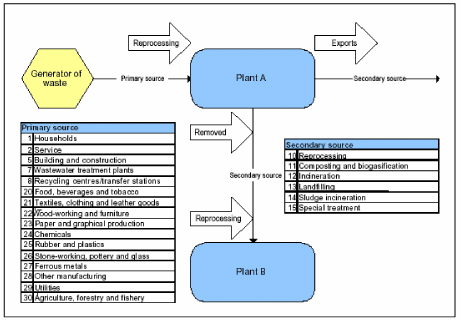
The Danish EPA carries out quality assurance of the information it receives and collects additional information from sector organisations and other sources. Each year the Danish EPA prepares a publication called "Waste Statistics", which gives an overview of waste composition and waste arisings in Denmark.
The publication also calculates the quantities of waste recycled, incinerated, and landfilled relative to the total waste amounts. Information is analysed between commercial sources and waste types.
New methods
Since 2001 data have been reported according to new rules set out in Statutory Order No. 619 of 27 June 2000 on waste (Statutory Order on Waste). These new rules have entailed a number of changes to the ISAG. For example, the source "manufacturing etc." was discontinued, so that since 2001 breakdown of industrial waste has been divided between 11 sectors.
Since 2001 there has been a shift between sectors in that waste volumes from industry have been falling, while waste volumes from the service sector have been rising. Waste volumes from industry thus fell by 37 per cent in the period 2000 to 2005, whereas in the service sector volumes increased by 65 per cent. From 2004 to 2005 waste volumes from industry and the service sector remained unchanged. That waste volumes from these two sources changed in the previous years may be due to faulty reporting as the source "manufacturing etc." was discontinued from 2001.
Structural changes, i.e. the fact that society is changing from an industrial to a knowledge society, may be another reason for the shift between the two sectors. The shift could be supported e.g. by the fact that from the early 1990s to 2003, the number of enterprises in traditional industry went down, while the number of new enterprises in the knowledge services industry increased dramatically.[1]
Packaging waste is a fairly new waste type in the ISAG and it does not yet reflect the total amount of cardboard and plastic packaging waste collected for recycling in Denmark. Parties reporting to the ISAG are therefore encouraged to be especially aware of this reporting possibility.
The principles for categorising waste from recycling centres/transfer stations with regard to the fractions glass and paper and cardboard have likewise been changed compared to the years 1994 to 2000. See Annex 2 for a more detailed explanation of the principles for this re-categorisation.
Please note that the changes to the way data is reported to the ISAG mentioned above, mean that care should be taken when comparing waste arisings at sector level from 2001 and later with waste arisings from previous years.
The government's Waste Strategy 2005-2008 presents a shift in focus from use of waste arisings as the only indicator for target fulfilment, to the supplementary use of new waste indicators for resource loss and environmental impacts.
Reading guide
Waste Statistics 2005 follows the same structure as previous reports: Chapter 1 describes general trends in waste generation, while Chapter 2 deals with waste recycling.
Chapter 3 deals with generation and treatment of hazardous waste, and Chapter 4 describes developments in imports and exports, both for ordinary waste and waste subject to mandatory notification.
Chapter 5 describes developments in waste arisings and treatment of waste from individual sources. Furthermore, this Chapter assesses the level of achievement of targets for treatment in the Danish government's Waste Strategy 2005-2008.
Chapter 6 presents the latest figures for the number of Danish incineration plants and landfills.
In Chapter 7 the trend in waste arisings is compared with overall economic growth to show how these relate to each other. Furthermore, this chapter takes a look at expected future waste arisings.
For the first years, tables and figures will show figures for every second year; whereas for the most recent years, there will be figures for each year. This is due to visual scope and to make it possible to present the tables in a format big enough to read.
Summary and conclusions
The 2005 reporting to the ISAG comprises 383 plants owned by 248 enterprises. In 2004, reports covered 394 plants owned by 256 enterprises. [2]
Waste generation in 2005 is compared to targets for 2008 in the government's Waste Strategy 2005-2008.
The following summarises waste generation in 2005:
- In 2005, total reported waste arisings amounted to 14,210,000 tonnes, which is 851,000 tonnes, or 6 per cent, more than in 2004.
- If amounts of residues from coal-fired power plants are excluded from statistics, waste arisings in 2005 were 13,129,000 tonnes, which is an 8 per cent increase on 2004.
- If amounts of residues from coal-fired power plants and waste from the building and construction sector are excluded from statistics, total waste generation in 2005 amounted to 7,859,000 tonnes, which is 175,000 tonnes, or 2 per cent, more than in 2004. In other words, there has been an increase in total waste arisings, if residues and waste from building and construction are excluded. Waste from the building and construction sector is more sensitive to economic change than most other waste.
- The total rate of recycling was 67 per cent. The 2008 target for recycling is 65 per cent. In 2004 the total rate of recycling was 65 per cent.
- The total amount of waste led to incineration amounted to 24 per cent, plus an additional approx. 1 per cent left in temporary storage to be incinerated at a later time. The 2008 target for incineration is 26 per cent. The amount of waste which is incinerated has dropped by 2 per cent since 2004, while the amount in storage has remained almost unchanged.
- The total amount of waste led to landfills amounted to 7 per cent, which is two percentage points better than the overall landfill target of a maximum of 9 per cent landfilling in 2008. In 2004, 8 per cent was landfilled.
- The targets for treatment of waste from some of the individual sectors are still not being met: too little waste from the service sector is being recycled, and too much waste from industry is being led to landfills. However, the trend is going in the right direction.
1 Waste generation and treatment
- 1.1 Waste generation 2005 and developments 2004-2005
- 1.2 Waste management in 2005
- 1.3 Treatment of waste without residues and construction and demolition waste
- 1.4 Treatment by source and waste type
- 1.5 Developments in waste generation 1994-2005
1.1 Waste generation 2005 and developments 2004-2005
Waste generation in 2005 and developments in waste arisings from 2004 to 2005 are presented in Table 1.
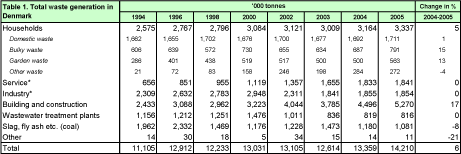
Source: ISAG; Danisco; the Association of Danish Recycling Industries and large scrap dealers; Elsam; Energi E2; and Reports to the Danish EPA on sludge from municipal wastewater treatment plants applied to farmland etc., and incineration of sludge at sludge incineration plants. (For sludge for recycling and incineration, figures from 2002 have been applied to 2005 - see footnote 26). Sludge is stated in wet weight, however from 2001 sludge for mineralisation which has been adjusted to 20 per cent dry matter. Sludge for long-term storage has been included in sludge amounts applied to farmland etc. Sludge for recovery has been included in sludge amounts for incineration.
The figures do not include imports of waste. Waste generation is stated as amounts of waste delivered to treatment plants from all primary sources. Primary sources include waste generators other than waste treatment plants (reprocessing plants, incineration plants, composting/biogas plants and landfills). Slag, fly ash and flue-gas cleaning products from waste incineration plants are therefore not included in the statement, as this would result in the waste being counted twice. Moreover, waste from the primary source recycling centres/transfer stations has been allocated among the other primary sources. The principles behind this allocation are explained in Annex 2.
Other waste includes the fractions packaging waste, plastic, sludge, and electrical and electronic equipment.
*The figures pertaining to service and industry from 2001 and onwards should be interpreted with some caution since there are fluctuations in the figures for the two sources which cannot be readily explained.
In 2005, Danish waste generation amounted to 14,210,000 tonnes. This corresponds to an increase of 6 per cent on the 2004 figure. Most of this increase stems from a 17 per cent increase in construction and demolition waste. Waste amounts of slag, fly ash, etc. have gone down 8 per cent.
Waste from households amounted to 3,337,000 tonnes in 2005. This is a 5 per cent increase in waste generation compared to 2004. The four types of waste from households either show no changes or have fluctuated slightly.
Domestic waste arisings remain almost unchanged from previous years. As Table 1 shows, domestic waste arisings have increased by a total of 3 per cent during the period 1994 - 2005, showing only very slight changes from year to year[3]. Domestic waste includes separately collected paper, glass, organic waste, and other waste.
The amount of bulky waste increased dramatically by 15 per cent, or 104,000 tonnes, compared to 2005. The increase in amounts of bulky waste can be ascribed e.g. to the fact that people have a greater disposable income and therefore home refurbishment etc. and procurement of new furniture etc. are more frequent.
The amount of waste reported as other waste fell by 4 per cent, which corresponds to 12,000 tonnes. Packaging waste is included under other waste. Separated packaging waste became subject to reporting to the ISAG for the first time in 2001. However, this waste type is still not being reported to a sufficient extent. Therefore, packaging waste reported to the ISAG does not give a real picture of the total amount of collected packaging waste.
Waste from the service sector amounted to 1,841,000 tonnes in 2005, which is a slight increase on 2004; in absolute figures an increase of 8,000 tonnes. Waste from the service sector includes waste from institutions, trade and offices.
Waste from industry is more or less the same as in 2004. In reality, however, there has been a drop of in the waste volume of 1,000 tonnes compared to 2004.
Since 2001 there has been a shift between sectors in that waste volumes from industry have been falling, while waste volumes from the service sector have been rising. Waste volumes from industry thus fell by 37 per cent in the period 2000 to 2005, whereas in the service sector volumes increased by 65 per cent. From 2004 to 2005 the amount of waste from industry and the service sector has remained unchanged. That waste volumes from these two sources changed significantly in the previous years may be due to faulty reporting as the source "manufacturing etc." was discontinued from 2001.
Structural changes, i.e. the fact that society is changing from an industrial to a knowledge society, may be another reason for the shift between the two sectors. The shift could be supported e.g. by the fact that from the early 1990s to 2003, the number of enterprises in traditional industry has gone down, while the number of new enterprises in the knowledge services industry has increased dramatically[4].
However, it is interesting how the shift between the two sectors seems to have evened out. This could be interpreted as reflective of a better registration practice, bearing in mind the structural changes mentioned above, and the fact that waste arisings might be settling at a natural level. Future statistics will tell if this is the case.
The generation of waste in the building and construction sector increased dramatically from 2004 to 2005. Volumes of construction and demolition waste amounted to 5,270,000 tonnes in 2005, which is 774,000 tonnes, or 17 per cent, more than in 2004. This increase is present in the following fractions: various non-combustible, concrete, asphalt, soil and stone, other recyclable waste, and other waste. These fractions rose by 22 per cent, 13 per cent, 3 per cent, 41 per cent, 18 per cent and 21 per cent, respectively. On the other hand, the fractions tile and other construction/demolition waste fell by 2 per cent and 11 per cent respectively. (See Table 30).
The explanation for the dramatic increase in the amount of soil and stone is increased activity in the building and construction sector. By far the major part, or 94 per cent, of waste generated by the building and construction sector is recycled. A total of 565,000 more tonnes of soil and stone were reported in 2005.
The amount of sludge from municipal wastewater treatment plants has remained more or less the same as in 2004. In 2005 the amount was 816,000[5] tonnes stated as 20 per cent dry-matter content. Therefore 3,000 tonnes less has been registered than in 2004.
Waste generation at coal-fired power plants fell by 8 per cent, from 1,180,000 tonnes in 2004 to 1,081,000 tonnes in 2005. This is primarily due to the fact that Denmark's actual consumption of coal for energy generation fell significantly from 2004 to 2005. In the period 1996 to 2000, there was a fall in waste arisings from coal-fired power plants. This can be attributed e.g. to the fact that there has been a conversion of energy generation from coal to renewable energy resources. In 2000 and 2005, Denmark had net imports of electricity[6].
1.2 Waste management in 2005
In the following, developments in Danish management of total waste arisings are described. Waste management is compared to treatment targets in the Danish government's Waste Strategy 2005-2008.
Table 2 shows that 9,545,000 tonnes, corresponding to 67 per cent of total waste arisings, were recycled in 2005. In absolute figures, this is an increase of 799,000 tonnes in recycled waste relative to 2004.

Source: same as Table 1, and the Danish government's Waste Strategy 2005-2008.
The total sum of the percentage distribution between the different treatment options for 2001, 2003, 2004 and 2005 does not add up to 100 per cent due to rounding.
Special treatment includes treatment of hazardous waste, including healthcare risk waste.
The amount of waste incinerated in 2005 came to 3,473,000 tonnes. This is inclusive of 339,000 tonnes of sludge from municipal wastewater treatment plants. This is actually a 36,000-tonne increase in waste amounts compared to the previous year, and it corresponds to 24 per cent of total waste arisings.
Waste led to landfill in 2005 amounted to 983,000 tonnes, which is a decrease of 41,000 tonnes from 2004. The rate of waste landfilled amounts to 7 per cent of total waste arisings. The percentage share of waste led to landfills fell by 62 per cent in the period 1994 to 2005, corresponding to a fall in landfilled waste amounting to 1,630,000 tonnes.
As the table shows, the relative distribution in recent years among treatment options has varied only little. Variations are often explained by developments in waste arisings in individual fractions. For example, variations in amounts of residues from coal-fired power plants and construction and demolition waste have large implications on the total rate of recycling, as these two waste types account for a large percentage of total waste arisings and typically have a rate of recycling of 90 per cent or more.
In the Danish government's Waste Strategy 2005-2008 the target of stabilising Danish waste generation is supplemented by a number of qualitative elements such as better exploitation of resources in waste, better quality in treatment of waste, and limitation of problems caused by environmental contaminants in waste.
Overall waste treatment targets for 2008 in the government's Waste Strategy 2005-2008 are 65 per cent recycling, 26 per cent incineration, and a maximum of 9 per cent landfilling.
As can be seen from Figure 1, the overall targets for treatment of waste in 2008 were met in 2005 and were already met for the first time in 2003. In 2004, one per cent of total waste arisings was reported under the treatment option storage. Storage means temporary landfilling of waste suitable for incineration until incineration capacity is available. This means that the waste is stored until it can be incinerated for the purpose of energy/heat generation.
The general fall in the rate of waste led to landfills can be attributed to the ban on landfilling of waste suitable for incineration that came into effect on 1 January 1997. However, there are other important factors as well.
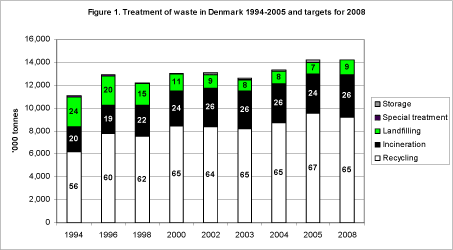
Source: same as Table 1. Note that total waste arisings in 2008 have been set to correspond to waste arisings in 2005. This should not be seen as a projection of developments in total waste arisings.
The amount of residues from coal-fired power plants was reduced significantly and recycled to a greater extent. Thus as opposed to previously, a larger proportion was recycled rather than landfilled.
1.3 Treatment of waste without residues and construction and demolition waste
Amounts of residues from coal-fired power plants not only depend on energy consumption in Denmark, but also on exports of electricity to Sweden and Norway. Furthermore the change from use of coal and coke as fuel to natural gas and renewable energy continues to take pace.
Since 1996, when Denmark's electricity exports to Sweden and Norway were particularly large, amounts of residues decreased steadily up until and including 2005. In fact, this is a 1,251,000-tonne decrease (see Table 32), corresponding to a 54 per cent reduction. In the period 2004 to 2005, there has been a fall of 99,000 tonnes, which is primarily attributable to falling exports of electricity to e.g. Sweden, Norway, and Germany. Thus, net exports fell by 148 per cent from 2004 to 2005.[7]
Naturally, this has an impact on developments of total waste arisings, but as residues have a very high rate of recycling, it also has an impact on the ability to meet overall treatment targets.
A similar picture is seen for construction and demolition waste. As discussed in section 5.4, the rate of recycling of construction and demolition waste typically reaches around 90 per cent.
It is therefore interesting to look at the distribution of waste between the different treatment options, if residues and construction and demolition waste are excluded from the statistics.
Figure 2 shows the distribution between the different treatment options when residues from coal-fired power plants are excluded from the statistics.
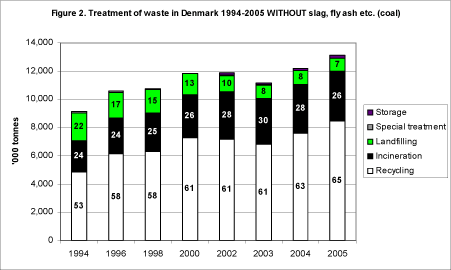
Source: same as Table 1.
When residues are excluded it is seen that 65 per cent of remaining waste was recycled in 2005, which is an increase of 880,000 tonnes compared to total amounts in 2004. This more or less means that a substantial part of the increase in overall waste arisings is to be found in construction and demolition waste volumes, of which, as mentioned, a large part is being recycled.
The rate of remaining waste in 2005 which was incinerated is 26 per cent, which is to say that 36,000 tonnes more waste were incinerated in 2005 than in the year before. The proportion of waste led to landfills was 7 per cent. In absolute figures this means that 23,000 tonnes less waste was landfilled in 2005 than in 2004.
In absolute figures this means that in 2005, apart from residues, 13,129,000 tonnes of waste were generated, corresponding to an increase of 8 per cent on 2004. Of this, 8,492,000 tonnes were recycled, whereas 3,473,000 tonnes were incinerated, and 955,000 tonnes were landfilled. Moreover, 18,000 tonnes were given special treatment and 191,000 tonnes have been temporarily landfilled until incineration capacity becomes available[8].
Total waste amounts without waste from coal-fired power plants increased by 44 per cent from 1994 to 2005.
Waste from the building and construction sector has also been excluded from statistics in Figure 3. As is evident, this will make the recycling rate fall and the rate of waste which is incinerated or landfilled grow.
In absolute figures, waste generation without residues and without waste from building and construction amounted to 7,859,000 tonnes in 2005, which is 175,000 tonnes, or about 2 per cent, more than in 2004. In other words, there has been a slight increase in total waste arisings, if residues and waste from building and construction are excluded. This increase is explained by an overall increase of waste from households of 173,000 tonnes from 2004 to 2005. (See Table 1).
Residues from coal-fired power plants and construction and demolition waste are recycled to a very large extent: in 2005, 97 per cent and 94 per cent respectively, cf. Chapter 5. As can be seen from Figure 3, the high recycling rates for these two sources contribute significantly to the overall recycling rate for the remaining waste. Since, proportionally, construction and demolition waste constitutes a large part of overall waste arisings, it means that the recycling rate falls when this waste type is excluded from the statement.
The recycling of residues from coal-fired power plants and construction and demolition waste will therefore also have a great influence on fulfilling the treatment targets set out in the government's Waste Strategy 2005-2008.
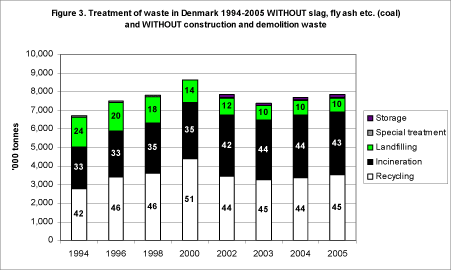
Source: same as Table 1.
1.4 Treatment by source and waste type
Figure 4 shows total waste generation in 2005 analysed by source and treatment option. Figure 5 shows waste generation analysed by waste type and treatment option. Tables with detailed figures are given in Annex 1.
Figure 4 shows that especially waste from the building and construction sector, power plants, industry and wastewater treatment plants is characterised by very high recycling rates. Consequently, the targets for recycling set out in Waste Strategy 2005-2008 have been met for waste generated by these four sectors (see Annex 1).
The high rate of recycling for industry is especially attributable to recycling of ferrous metal. Despite the fact that the amount of waste from industry led to landfill is falling, too much waste from this sector is still being landfilled with 19 per cent against a target of 15 per cent. A challenge lies ahead to divert larger amounts of the other fractions besides ferrous metal from landfilling to incineration or recycling.
The recycling rate for waste from the service sector has increased considerably. Thus, in 2005, 45 per cent of the waste from this sector was recycled, whereas, in 2004, only 36 per cent was recycled. The target for recycling of waste from the service sector is 50 per cent by 2008.
Too much waste is still being landfilled: 8 per cent against a target of 5 per cent. For the service sector the challenge is therefore to divert more waste from landfilling to recycling.
Treatment of the waste type domestic waste has almost reached the target for 2008. Thus, in 2005, 18 per cent of this waste type was recycled against a target of 20 per cent by 2008. In the period 1994 to 2005 the recycling rate fluctuated between 14 per cent and 18 per cent (see also Figure 7).
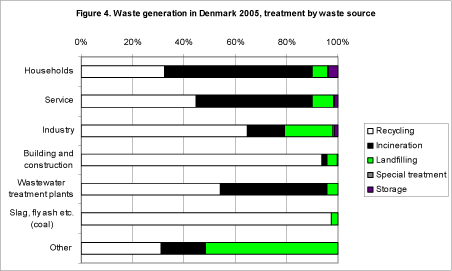
Source: same as Table 1.
The target is to reach a recycling rate for domestic waste of 20 per cent in 2008, whereas the targets for incineration and landfilling are 80 per cent and 0 per cent respectively. The rate of domestic waste incinerated in 2005 reached 81 per cent, whereas about 1 per cent was led to landfill[9].
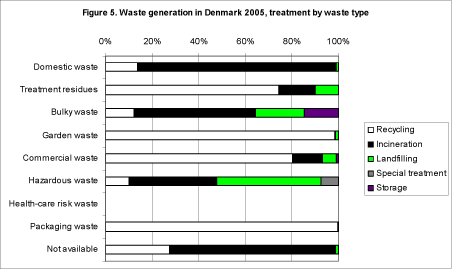
Source: same as Table 1.
1.5 Developments in waste generation 1994-2005
Table 3 shows total waste arisings in Denmark for the years 1994 to 2005. Breakdown of the information is by source.
There was a 28 per cent increase in total waste arisings in the period 1994 to 2005.
Waste generation was largest in 2005.
In the period 1994 to 2005, waste arisings have fluctuated, but have stayed at around 13 million tonnes in recent years, however with greater increases in 2004 and 2005. As in 2004, the great increase in waste arisings in 2005 is due to growing waste amounts from building and construction. Soil and stone is the waste type that has grown the most, due to a growing number of building and construction works. The total amount of construction and demolition waste increased by 775,000 tonnes from 2004 to 2005. Of this increase, soil and stone accounted for 565,000 tonnes.
The increase in waste arisings in the first half of the 1990s may be due partly to the fact that coverage of the ISAG system increased and partly due to real increases in waste arisings.
The large amounts of waste in 1996 were primarily due to particularly high amounts of residues from coal-fired power plants in 1996, which in turn were due to large exports of electricity to Sweden and Norway. However, increasing waste arisings in 2000 must be attributed to an increase in waste from households and waste from building and construction. The same applies for 2002. As mentioned, for 2004 and 2005, the increase in waste arisings must be ascribed to more waste from the building and construction sector.
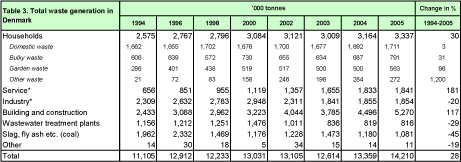
Source: same as Table 1.
Other waste includes the fractions packaging waste, plastic, sludge, and electrical and electronic equipment.
*The figures pertaining to service and industry from 2001 and onwards should be interpreted with some caution since there are fluctuations in the figures for the two sources which cannot be readily explained.
2 Recycling
- 2.1 Recycling by fraction
- 2.2 Paper and cardboard
- 2.3 Plastic
- 2.4 Bottles and glass
- 2.5 Ferrous metal
- 2.6 Organic waste for composting, wood chipping and biogasification
- 2.7 Tyres
2.1 Recycling by fraction
Table 4 shows the amounts separated from the different waste fractions for the purpose of recycling in the form of either reprocessing, composting or biogasification. The Table does not show the total amount of waste generated by the individual fraction.
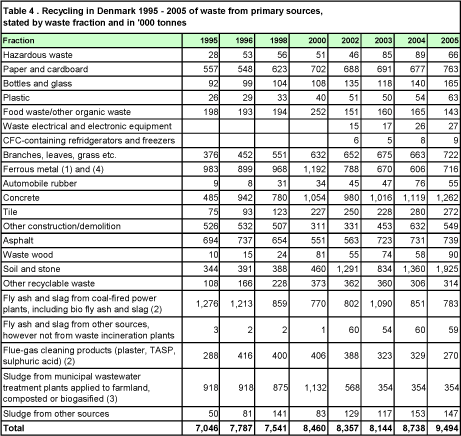
Source: the ISAG and (1) Recycling industries and other large scrap dealers. (2) Elsam and Energi E2. (3) Reports to the Danish EPA on sludge from municipal wastewater treatment plants applied to farmland etc. Data has been delayed a year so that 2002 figures are used for 2003, 2004 and 2005, and 2001 figures are used for 2002 (see also 5.6). Sludge for long-term storage has been included in the amount for recycling. (4) To avoid double reporting, figures have been corrected for ferrous metal removed from waste incineration plants.
The Table shows that in 2005 9,494,000 tonnes of waste were recycled. This is 9 per cent, or 756,000 tonnes, more than in 2004. The increase is primarily due to more recycling of soil and stone, while there has also been an increase in the amount of concrete and ferrous metal recycled. Fly ash and slag from coal-fired power plants fell by 68,000 tonnes, while other construction/demolition waste has gone down by 83,000 tonnes. Otherwise, there are no large fluctuations evident for the individual fractions.
2.2 Paper and cardboard
Consumption of virgin paper and the rate of collection of waste paper in the period from 1994 to 2004 are shown in Table 5.
The total amount of waste paper collected in 2005 amounted to 677,000 tonnes. This constitutes a reduction of 14,000 tonnes or 2 per cent relative to the amounts collected in 2004.
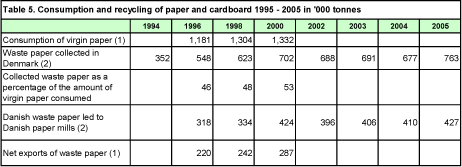
Source: (1) Statistics on recycling of packaging waste 2004. Danish EPA, Environmental Project No. 1129, 2006. (2) The ISAG reports.
Table 6 shows collected paper by source and by packaging waste and remaining waste types. Not surprisingly, the largest amounts of waste paper are collected from households, the service sector and industry. The largest amounts of packaging waste are collected from the service sector.
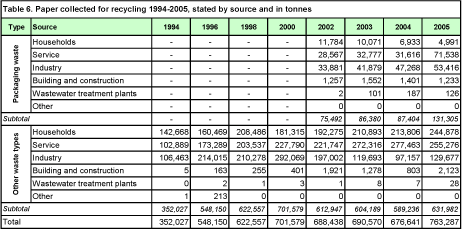
Source: ISAG reports 1994-2005. Note that double reporting in 1998 apparently explains why the total amount is about 20,000 tonnes too high.
Packaging waste is a new waste type in the ISAG and it does not yet reflect the total amount of cardboard packaging waste collected for recycling in Denmark. In 2004, 292,000 tonnes of paper and cardboard packaging waste were collected for recycling[10].
As is apparent from the table, the amount of paper collected for recycling has gone up by about 86,646 tonnes from 2004 to 2005. This increase primarily covers increasing amounts of packaging waste from the service sector (up 39,922 tonnes) and increasing amounts of other paper from industry (up 32,520 tonnes). The table also shows that the amount of recycled paper from households in the period 1994 - 2005 has increased by about 107,000 tonnes.
The amount of paper collected from the service sector has gone up by around 17,735 tonnes, or 6 per cent, amounting to 326,814 tonnes in 2005. The amount of paper collected from industry has increased by around 38,668 tonnes corresponding to 27 per cent compared to 2004.
In the ISAG, waste delivered to a recycling centre/transfer station is reported with the commercial source "recycling centre/transfer station". This means that it is not stated whether the waste originated from households or from other primary commercial sources. From 2001, recycling centres/transfer stations must indicate a split between waste types and primary source. Since this is not yet routine, the ISAG Secretariat has divided the waste as shown in Annex 2.
2.3 Plastic
Table 7 shows the amount of plastic collected for recycling, reported to the ISAG. In 2005 this amount was 63,058 tonnes, which is an increase of around 9,061 tonnes from 2004. However, it is assumed that some plastic has been collected and exported directly for recycling abroad without having been registered at a Danish treatment plant. It is therefore probable that the amount of waste plastic collected in Denmark is more than 63,058 tonnes.
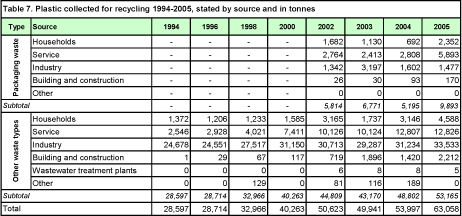
Source: ISAG reports 1994-2005.
The fraction plastic covers both production waste, plastic packaging waste, and other plastic waste, with individual figures shown in Table 7.
Packaging waste is a new waste type in the ISAG and it does not yet reflect the total amount of waste plastic packaging collected for recycling and reprocessing in Denmark. Therefore, in the following description of plastic recycling, ISAG figures have been supplemented with information from statistics on waste packaging.[11]
The statistics show that in 2004, 28,439 tonnes of waste plastic packaging were collected and recycled in Denmark. Of this amount, 17,131 tonnes were exported for recycling abroad.
The total amount collected corresponds to 16.3 per cent of the total Danish consumption of plastic packaging. This constitutes a drop from 2004, when 17.4 per cent of waste plastic packaging was collected for recycling. Waste plastic of the type polyethylene (PE) accounted for 70 per cent of collected amounts.
2.4 Bottles and glass
According to the ISAG reports, 165,094 tonnes of bottles and glass were collected for recycling in Denmark in 2005. This is 24,622 tonnes more than in 2004.
As seen in Table 8, the amount of glass collected for recycling went up by 55,566 tonnes, or 51 per cent, during the period 1994 to 2005. However, the figures fluctuate somewhat throughout the period. At the same time it is seen that the amount of glass packaging collected from households has dropped in the period 2002 to 2004.
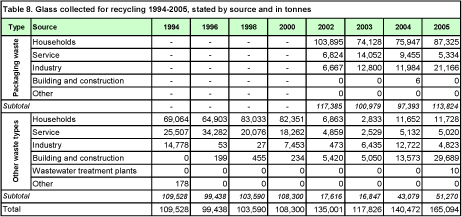
Source: ISAG reports 1994-2005.
It is evident from Table 8 that by far the major part of the glass collected is packaging waste: thus, packaging waste accounted for 69 per cent of the total amount of glass in 2005.
However, the ISAG does not provide a complete picture of the overall material flow. This is especially significant with regard to recycling of bottles and glass, which is a process comprising several collection, reuse and treatment steps before glass becomes waste.
Therefore, in the following description of overall glass recycling, ISAG information is supplemented with information from statistics for packaging waste[12], cf. Figure 6.
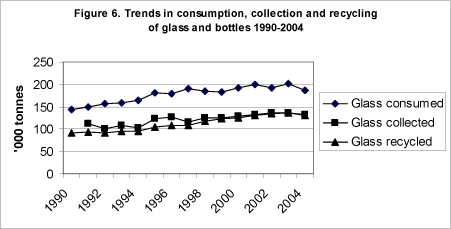
Source: Statistics for recycling of packaging waste 2004. Environmental Project No. 1129, 2006.
Apart from minor fluctuations, consumption of glass packaging increased throughout the period.
Correspondingly, the amount of glass packaging collected and recycled has increased. The amount of glass collected was 132,000 tonnes in 2004. This is around 6,000 tonnes less than in 2003. Amounts of recycled glass also dropped, namely from 137,000 tonnes in 2003 to 131,000 tonnes in 2004.
This means that in 2004 the collection rate as a percentage of total consumption reached 70 per cent, which is an increase of 2 percentage points compared to 2003. In 2003, the recycling rate as a percentage of total consumption reached 68 per cent.
Bottles for beer and soft drinks manufactured for reuse are not included in this statement. Refillable glass bottles, on average, make 30 trips. If these bottles were manufactured as single-use bottles, it would give an increase in waste glass of around 310,000 tonnes.
2.5 Ferrous metal
Table 9 shows the overall amount of ferrous scrap collected, analysed between consignees. It is seen that 475,000 tonnes of ferrous metal were recycled in 2005, which is a decrease of 159,000 tonnes, or 25 per cent, from 2004.

Source: (1) ISAG reports, (2) information from the Association of Danish Recycling Industries and other large scrap dealers. Note that calculations in Table 9 differ from those in Table 4. Amongst other things, the figures have not been corrected for amounts of ferrous metal removed from waste incineration plants. 2003 to 2005 saw a substantial drop in imports of ferrous scrap by foundries and the Danish Steel Works. This is because the Danish Steel Works was closed down and therefore no longer contributes to the ISAG.
Table 9 shows a drop from 2002 to 2005 of 93,000 tonnes, or 80 per cent, in the amount of ferrous scrap imported by foundries and the former Danish Steel Works. The Association of Danish Recycling Industries has reported that ferrous scrap not sent to the Danish Steel Works has been exported.
However, the Association of Danish Recycling Industries normally estimates a recycling rate for ferrous scrap in excess of 90 per cent.
According to reports to the Danish EPA, the Danish Steel Works and other Danish foundries imported 23,000 tonnes of ferrous scrap in 2005, whereas scrap dealers imported around 54,000 tonnes. In other words, total imports in 2005 amounted to 77,000 tonnes, which is 5,000 tonnes, or 6 per cent, less than in 2004.
Scrap dealers exported 494,000 tonnes of ferrous scrap in 2005, which means that net exports in 2005 were 440,000 tonnes. This is a fall of 11 per cent from 2004.
2.6 Organic waste for composting, wood chipping and biogasification
The amount of organic waste led to reprocessing in the form of composting, wood chipping, biogasification, or fodder is shown in Table 10.
Organic waste led to reprocessing in 2005 amounted to 1,257,000 tonnes. This is 28,000 tonnes more than in 2004. The increase is due in particular to the fact that the amount of branches, leaves etc. has increased by 55,000 tonnes.
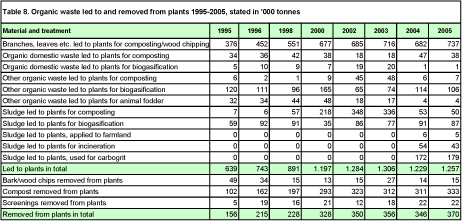
Source: the ISAG does not contain information on whether organic materials are reprocessed via composting, wood chipping or biogasification. Figures are based on assessments and calculations of data from the ISAG reports. See Annex 3 for a specification of waste types and plants included in the different categories .According to calculations in Statistics on treatment of organic waste from households 2001, Environmental Project No. 856, 2003, organic domestic waste led to composting and biogasification amounts to 37,000 tonnes.
The amount of bark/wood chips and compost removed from treatment plants does not reflect the total amount generated at the plants. Rather, this amount indicates the quantity sold or delivered free from the plants.
As is seen from the table, the amount of sold/removed bark/wood chips came to around 1,000 tonnes more than in 2004 while the amount of sold/removed compost was 22,000 tonnes more than in 2004.
2.7 Tyres
In 1995, the Minister for Environment and Energy entered an agreement with a number of organisations, on a take-back scheme for used tyres from cars, vans, and motorcycles.
The purpose of the agreement is to ensure collection and recycling of used tyres in Denmark. In this way, landfilling is avoided and appropriate resource recovery ensured which prioritises recycling over energy recovery.
The scheme commenced on 1 April 1995 and is financed by a fee on all tyres covered by the agreement and marketed in Denmark.
According to the agreement, the target is a take-back rate of at least 80 per cent.
From 1 April 2000 the scheme was extended to cover tyres from all types of motor vehicles. This accounts for the leap in data between 1998 and 2000 in Table 11.
The table shows that the collection rate for waste tyres surpassed 100 per cent in 2002. According to reports from the Danish Tyre Trade Environmental Foundation, this is presumably due to the fact that waste tyres have been imported from Germany, as well as to the fact that some waste tyres have been collected and stored for several years.

Source: reports from the Danish Tyre Trade Environmental Foundation in 1996, 1998, 2000, 2002, 2003, 2004 and 2005.
3 Hazardous waste
Table 12 shows treatment of hazardous waste in 2004 and 2005 by main group. The calculation covers the amount of treated hazardous waste. A more detailed statement of hazardous waste, analysed by ISAG fractions is available in Annex 4. Table 12 has been changed somewhat from previous years to make it more comprehensible. This means that certain fractions are now only found in Annex 4.
Waste from secondary sources, such as waste from incineration plants, is not included in total waste generation, cf. Table 1. This is because the waste would otherwise be counted twice in the statistics: the first time upon receipt at the primary treatment plant and the second time as a residue. However, it may be reasonable to include waste from both primary and secondary sources when estimating capacity needs for hazardous waste management.
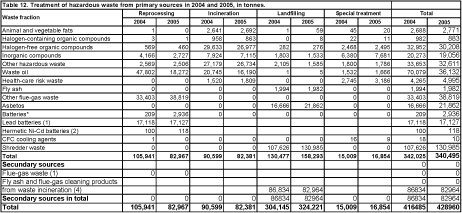
Source: ISAG reports 2004 and 2005, and (1) Registrations under the EU regulation on shipments of waste. (2) Danish EPA calculations. Double reporting may have occurred, because some of the hermetically sealed Ni-Cd batteries may have been included in the amount of batteries reported to the ISAG. (3) Elsam and Energi E2. (4) Based on the ISAG. It is expected that waste from secondary sources will be exported and landfilled abroad.
Shredder waste is included as a separate waste fraction in the table. Since shredder waste is reported as landfilled waste exempted from tax, the ISAG leaves no other option than including it under "other hazardous waste”. This waste fraction, however, is so large that this year we chose to include shredder waste in the statistics separately.
*There is some uncertainty about this figure as lead accumulators could have been registered under this item.
The table shows that hazardous waste from primary sources amounted to 340,495 tonnes in 2005. This is similar to last year. The three fractions which have gone down the most are: waste oil, organic and inorganic halogen-containing compounds. The drop in the amount of waste oil is attributable to a greater proportion being exported for recycling abroad. On the other hand, the amount of shredder waste has increased.
Hazardous waste from secondary sources amounted to 82,964 tonnes in 2005, which is 3,870 tonnes less than in 2004.
Tables 13, 14, 15 and 16 show the amounts of waste generated by the four sectors: households, service, industry, and building and construction.
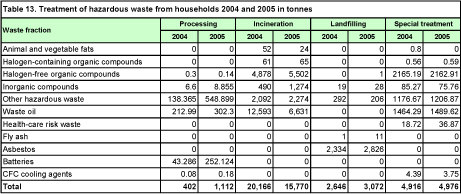
Source: ISAG 2004 and 2005.
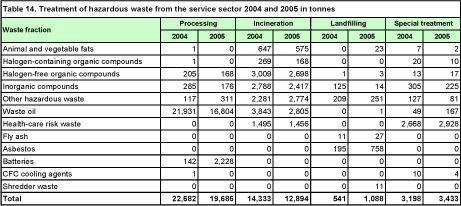
Source: ISAG 2004 and 2005.
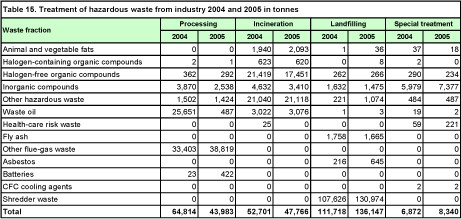
Source: ISAG 2004 and 2005.
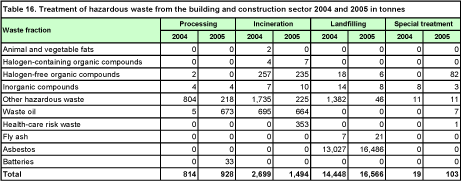
Source: ISAG 2004 and 2005.
The total amount of hazardous waste from industry is 236,236 tonnes, whereas the total amount from the service sector is 37,101 tonnes, the total amount from households is 24,930 tonnes, and the total amount from building and construction is 17,091 tonnes. A comparison of the total amounts of hazardous waste from the four sectors shows that industry generated almost three times as much hazardous waste as the three remaining sectors put together.
The building and construction sector, which generates least hazardous waste, has one primary source of hazardous waste, namely asbestos. Asbestos is also present in other sectors, however in significantly smaller quantities.
Healthcare risk waste from the service sector, or more precisely from hospitals, is another hazardous waste fraction primarily originating from one sector.
The three fractions waste oil, halogen-free organic compounds, and other hazardous waste occur in the largest amounts in industry, the service sector, and households. Organic compounds without halogens include e.g. solvents, dye/varnish/paint and tar, and rust-preventing oils.
Inorganic compounds are found in significant amounts in both industry and the service sector. This fraction is found only in small amounts in both households and the building and construction sector.
4 Imports and exports of waste
- 4.1 Imports
- 4.2 Exports
- 4.3 Imports and exports of waste subject to mandatory notification
- 4.4 OECD codes
4.1 Imports
Table 17 shows the amount of waste imported to Denmark in 2004 and 2005 by waste fraction and treatment option. In 2005, 486,098 tonnes of waste were imported, which is 25,035 tonnes less than in 2004.
The amount of waste imported in 2005 corresponds to around 6 per cent of total waste generated in Denmark. This is somewhat more than in 2004 when the amount imported was about 4 per cent.
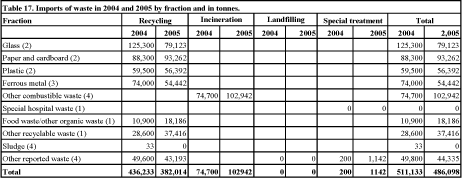
Source: (1) ISAG reports; (2) Statistics Denmark; (3) Association of Danish Recycling Industries and other large scrap dealers; (4) registrations under the EU regulation on shipments of waste: Council Regulation No. 259/93 on the supervision and control of shipments of waste within, into and out of the European Community.
Around 62 per cent of imported waste is categorised pursuant to the EU regulation on shipments of waste[13] as so-called green waste for recovery. Green waste covers primarily glass, paper and cardboard, plastic and ferrous metal. Green waste is not subject to mandatory notification under the EU regulation on shipments of waste.
Waste imported belonging to the category "other combustible waste" is destined for incineration with energy recovery, and comprises different types of waste oil. This is waste subject to mandatory notification and it is therefore also included in Table 19.
4.2 Exports
Table 18 shows the amount of waste exported from Denmark in 2004 and 2005. The amount of waste exported from Denmark in 2005 corresponded to around 11 per cent of the total waste generated in Denmark.
In 2005, waste exports amounted to 1,557,682 tonnes, or 61,988 tonnes less than in 2004. The fall can be attributed to a smaller amount of ferrous metal, namely 77,000 tonnes, and residues from coal-fired power plants, namely 50,000 tonnes. A detailed statement of the amount of exported waste subject to mandatory notification is found in Table 19.
Around 69 per cent of waste exported from Denmark in 2005 belongs to the category "green waste for recovery". This category includes the fractions glass, paper and cardboard, plastic, and ferrous metal.
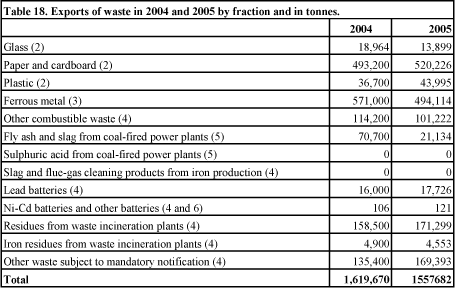
Source: (1) ISAG reports; (2) Statistics Denmark; (3) Association of Danish Recycling Industries and other large scrap dealers; (4) registrations under the EU regulation on shipments of waste: Council Regulation No. 259/93 on the supervision and control of shipments of waste within, into and out of the European Community, (5) Elsam and Energi E2, (6) Registrations by the Danish EPA.
4.3 Imports and exports of waste subject to mandatory notification
Table 19 shows the countries to and from which Denmark has exports and imports of waste subject to mandatory notification. Waste subject to mandatory notification means waste that must be notified to the competent authorities of dispatch and the competent authorities of destination according to Council Regulation No. 259/93 on the supervision and control of shipments of waste within, into and out of the European Community.
As can be seen from the table, in 2005 Denmark imported 1,043 tonnes of waste for disposal, which is about 800 tonnes more than in 2004. This waste originated primarily from the Netherlands and consisted mainly of acidic solutions.
In 2005, Denmark imported around 146,000 tonnes of waste for recovery. Most of this waste originated from Norway and Sweden and consisted primarily of unlisted waste and mixtures of waste oil emulsions.
The amount of imported waste in 2003 destined for recovery rose by 21,751 tonnes compared to 2004, when around 124,000 tonnes of waste were imported.
Waste subject to mandatory notification exported for disposal amounted to 231,408 tonnes in 2005, which is 8,726 tonnes more than in 2004. This waste was exported to Norway and Germany and primarily consisted of residues from waste incineration plants.
In addition, Denmark exported 232,923 tonnes of waste subject to mandatory notification destined for recovery. This is 26,606 tonnes more than in 2004. Countries of destination were primarily Sweden and Germany. The waste types concerned were primarily unlisted waste, wood waste, lead batteries and waste oil.
Table 19. Imports and exports of waste subject to mandatory notification, 2005.
Stated in tonnes.
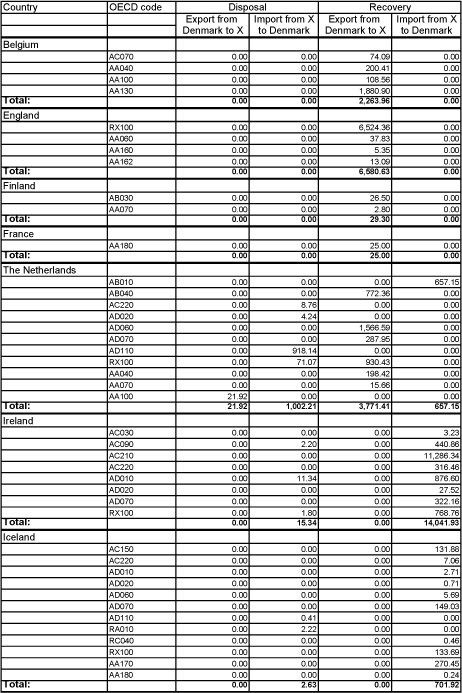
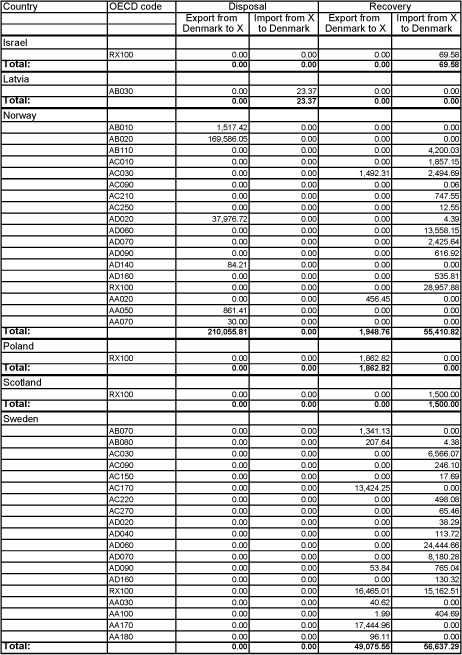
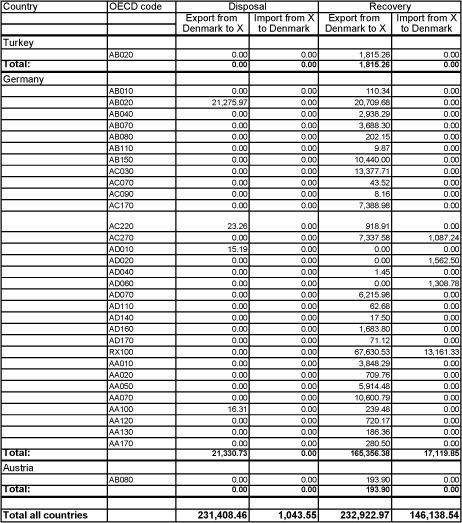
Source: Danish EPA Transport Database. The reporting is based on reporting of shipments completed under the EU regulation on shipments of waste (Council Regulation No 259/93). The competent authorities of destination must submit copies of the completed consignment note to the competent authorities involved no later than 3 days from receipt of the waste. No later than 180 days after receipt of the waste, the consignee must send proof that the waste has been recovered. OECD waste codes are described in detail in Commission Decision of 21 October 1994 (OJ 1994 L288/36).
4.4 OECD codes
| AA010 | Dross, scalings and other wastes from the manufacture of iron and steel. |
| AA020 | Zinc ashes and residues. |
| AA030 | Lead ashes and residues. |
| AA040 | Copper ashes and residues. |
| AA050 | Aluminium ashes and residues. |
| AA060 | Vanadium ashes and residues |
| AA070 | Ashes and residues containing metals or metal compounds not elsewhere specified or included. |
| AA080 | Thallium waste and residues. |
| AA090 | Arsenic waste and residues. |
| AA100 | Mercury waste and residues. |
| AA110 | Residues from alumina production not elsewhere specified or included. |
| AA120 | Galvanic sludge. |
| AA130 | Liquors from the pickling of metals. |
| AA140 | Leaching residues from zinc processing, dusts and sludge such as jarosite, hematite, goethite, etc. |
| AA150 | Precious metal bearing residues in solid form which contain traces of inorganic cyanides |
| AA160 | Leaching residues from zinc processing, dusts and sludge such as jarosite, hematite, goethite, etc: |
| AA161 | Ash from incineration of printed circuit boards |
| AA162 | Photographic film ash. |
| AA170 | Lead-acid batteries, whole or crushed. |
| AA180 | Used batteries or accumulators, whole or crushed, other than lead-acid batteries and waste and scrap arising from the production of batteries and accumulators, not otherwise specified or included. |
| AA190 | Magnesium waste and scrap that is flammable, pyrophoric or emits, upon contact with water, flammable gases in dangerous quantities. |
| AB010 | Slag, ash and residues, not elsewhere specified or included. |
| AB020 | Residues arising from the combustion of municipal/household wastes. |
| AB030 | Waste from non-cyanide based systems which arise from surface treatment of metals. |
| AB040 | Glass waste from cathode-ray tubes and other activated glasses. |
| AB050 | Calcium fluoride sludge. |
| AB060 | Other inorganic fluorine compounds in the form of liquids or sludge. |
| AB070 | Sands used in foundry operations. |
| AB080 | Waste catalysts not on the green list. |
| AB090 | Waste hydrates of aluminium. |
| AB100 | Waste alumina. |
| AB110 | Basic solutions. |
| AB120 | Inorganic halide compounds, not elsewhere specified or included. |
| AB130 | Used blasting grit. |
| AB140 | Gypsum arising from chemical industry processes. |
| AB150 | Unrefined calcium sulphite and calcium sulphate from flue gas desulphurization (FGD). |
| AC010 | Waste from the production/processing of petroleum coke and bitumen, excluding anode butts. |
| AC020 | Asphalt cement wastes. |
| AC030 | Waste oils unfit for their originally intended use. |
| AC040 | Leaded petrol (gasoline) sludge. |
| AC050 | Thermal (heat transfer) fluids. |
| AC060 | Hydraulic fluids. |
| AC070 | Brake fluids. |
| AC080 | Antifreeze fluids. |
| AC090 | Waste from production, formulation and use of resins, latex, plasticisers, glues and adhesives. |
| AC100 | Nitrocellulose. |
| AC110 | Phenols, phenol compounds including chlorophenol in the form of liquids or sludge. |
| AC120 | Polychlorinated naphtalenes. |
| AC130 | Ethers. |
| AC140 | Triethylamine catalyst for setting foundry sands. |
| AC150 | Chlorofluorocarbons. |
| AC160 | Halons. |
| AC170 | Treated cork and wood wastes. |
| AC180 | Leather dust, ash, sludge and flours. |
| AC190 | Fluff light fraction from automobile shredding. |
| AC200 | Organic phosphorous compounds. |
| AC210 | Non-halogenated solvents. |
| AC220 | Halogenated solvents. |
| AC230 | Halogenated or unhalogenated non-aqueous distillation residues arising from organic solvent recovery operations |
| AC240 | Wastes arising from the production of aliphatic halogenated hydrocarbons. |
| AC250 | Surface active agents (surfactants). |
| AC260 | Liquid pig manure; faeces. |
| AC270 | Sewage sludge. |
| AD010 | Wastes from the production and preparation of pharmaceutical products. |
| AD020 | Wastes from the production, formulation and use of biocides and phytopharmaceuticals. |
| AD030 | Wastes from the manufacture, formulation and use of wood preserving chemicals. |
| AD040 | Inorganic cyanides, excepting precious metal-bearing residues in solid form containing traces of inorganic cyanides. |
| AD050 | Organic cyanides. |
| AD060 | Waste oils/water, hydrocarbons/water mixtures, emulsions. |
| AD070 | Wastes from production, formulation and use of inks, dyes, pigments, paints, lacquers, varnish. |
| AD080 | Wastes of an explosive nature, when not subject to specific other legislation. |
| AD090 | Wastes from production, formulation and use of reprographic and photographic chemicals and materials not elsewhere specified or included. |
| AD100 | Wastes from non-cyanide based systems which arise from surface treatment of plastics. |
| AD110 | Acidic solutions. |
| AD120 | Ion exchange resins. |
| AD130 | Single-use cameras with batteries. |
| AD140 | Wastes from industrial pollution control devices for cleaning of industrial off-gases, not elsewhere specified or included. |
| AD150 | Naturally occurring organic material used as a filter medium (such as bio-filters). |
| AD160 | Municipal/household wastes. |
| AD170 | Spent activated carbon having hazardous characteristics and resulting from its use in the inorganic chemical, organic chemical and pharmaceutical industries, waste water treatment, gas/air cleaning processes and similar applications. |
| RA010 | Wastes, substances and articles containing, consisting of or contaminated with polychlorinated biphenyl (PCB) and/or polychlorinated terphenyl (PCT) and/or polybrominated biphenyl (PBB), including any other polybrominated analogues of these compounds, at a concentration level of 50 mg/kg or more. |
| RA020 | Waste tarry residues (excluding asphalt cements) arising from refining, distillation and any pyrolitic treatment. |
| RB010 | Asbestos (dusts and fibres). |
| RB020 | Ceramic-based fibres of physico-chemical characteristics similar to those of asbestos. |
| RC010 | Wastes that contain, consist of or are contaminated with any congenor of polychlorinated dibenzo-furan |
| RC020 | Wastes that contain, consist of or are contaminated with any congenor of polychlorinated dibenzo-dioxin |
| RC030 | Leaded anti-knock compounds sludge. |
| RC040 | Peroxides other than hydrogen peroxide. |
| RX100 | Other wastes not specified with an OECD code. |
5 Individual waste sources and status in relation to targets for 2008
- 5.1 Waste from households
- 5.2 Waste from the service sector
- 5.3 Waste from industry
- 5.4 Waste from building and construction activities
- 5.5 Residues from coal-fired power plants
- 5.6 Sludge from municipal wastewater treatment plants
- 5.7 Residues from waste incineration plants
5.1 Waste from households
Waste from households covers the waste types domestic waste, bulky waste, and garden waste, which in turn are divided into individual fractions, e.g. paper and cardboard, bottles and glass, and food waste/other organic waste. Table 20 shows waste arisings by mixed and separately collected fractions to the extent it has been possible to register these individually.
This means, for example, that the amount of paper and cardboard stated does not show the complete potential in household waste arisings but only the amount which has been separated and collected for recycling. The rest of the paper is part of the fraction various combustible.
Waste arisings from households in 2005 amounted to around 3,338,000 tonnes, which constitutes a 6 per cent increase from 2004. The increase in the total amount of household waste can be tracked for the major part to the fractions various non-combustible and ferrous metal separated for recycling. These two fractions went up by 23 per cent and 21 per cent respectively.
The fraction various combustible, however, still makes up the largest part of total household waste arisings, namely around 61 per cent.

Source: ISAG reports. (1) For the year 1996, waste from the fraction ferrous metal is included under "Other waste".
Table 20 shows shifts between the different household waste fractions, so that various combustible, various non-combustible, paper and cardboard separated for recycling, bottles and glass separated for recycling, branches, leaves, grass etc. and ferrous metal separated for recycling have increased by 4 per cent, 23 per cent, 13 per cent, 13 per cent, 13 per cent and 21 per cent respectively, compared to 2004. Food waste/other organic waste separated for recycling, hazardous waste and other waste, on the other hand, went down by 15 per cent, 11 per cent and 26 per cent respectively relative to 2004.
5.1.1 Household waste per capita and per household
In Table 21, household waste arisings are stated per capita and per household. Furthermore, the Table shows total arisings analysed between selected waste types and separately collected waste fractions.
Total household waste generation per capita amounted to 617 kg in 2005, which is 31 kg more than in 2004. Household waste per household was 1336 kg in 2005.
Of these, domestic waste per capita and per household was 316 kg and 685 kg respectively in 2005. Compared to 2004, this means a slight increase of 3 kg per capita, while the amount per household grew similarly by 3 kg.
The table shows that bulky waste is the main contributor to the increase in waste arisings in the period. Bulky waste thus increased from 126 kg per capita in 2004 to 146 kg per capita in 2005. The reason for the increase must be ascribed to the fact that people have more disposable income and therefore the number refurbishments and procurement of new furniture have gone up.

Source: ISAG reports. Statistics Denmark's statement of population growth and number of households has been used. Note that Tables 20 and 21 are not readily comparable, as Table 20 concerns waste generation stated by fraction while Table 21 also includes waste types.
5.1.2 Domestic waste
Domestic waste from households covers ordinary waste from private household consumption. This includes paper, bottles, glass, organic food waste and other waste. Usually, domestic waste is collected from households at regular intervals, once a week or once every other week.
As mentioned in Chapter 1, domestic waste amounted to 1,711,000 tonnes in 2005, which is 19,000 tonnes more than in 2004. Since 1994, the amount of domestic waste has varied slightly from year to year, however, without showing any clear trend. The amount has increased by 3 per cent over the entire period, cf. Table 3.
In 2005, 18 per cent of domestic waste was recycled, whereas 81 per cent was incinerated and about 1 per cent landfilled. The breakdown by treatment option therefore shows slight changes from 2004 when 17 per cent was recycled, 83 per cent was incinerated and around 1 per cent landfilled.
For the early years, packaging waste is included as part of the waste type domestic waste. To make comparison with these early years possible, packaging waste from households in 2001, 2002, 2003, 2004 and 2005 of 107,000, 117,000, 85,000, 84,000 and 96,000 tonnes respectively has been included in Figure 7.
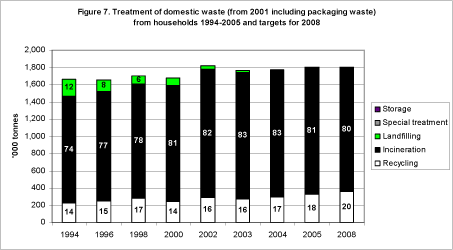
Source: same as Tables 1 and 2. Note that arisings in 2008 have been set to correspond to arisings in 2005. The figures are not projections of developments in waste arisings.
Figure 7 shows that the relative distribution in the period 1994 to 2005 among treatment options has varied only little. From 1994 over the entire period the trend has been that 80 per cent of domestic waste is incinerated. Recycling is 16 per cent and landfilling 5 per cent. At the same time, the figures show that the amount of waste led to landfills has gone down.
Even though the targets in Waste Strategy 2005-2008 are close to being met, too much domestic waste is still being incinerated and landfilled relative to the targets, and too little recycled.
One of the measures which can help ensure greater recycling of domestic waste is the requirement that, from August 2006, Danish municipalities are obliged to separate plastic and metal packaging waste from households for recycling. Waste, which so far has been led to incineration.
It should be noted that domestic waste is considered suitable for incineration and it is therefore not to be landfilled. If not recycled, domestic waste is to be incinerated. However, islands that are not connected by land to an incineration plant are exempt from this obligation.

Source: same as Tables 1 and 2. Note that arisings in 2008 have been set to correspond to arisings in 2005. The figures are not projections of developments in waste arisings.
5.1.3 Bulky waste
Bulky waste generated by Danish households amounted to 791,000 tonnes in 2005. This is 104,000 tonnes more than in 2004. In other words, there has been an increase of 15 per cent.
During the period from 1994 to 2005 bulky waste increased by 31 per cent. The increase in bulky waste amounts is due to a real increase but also very much to the implementation of pick-up and bring schemes for this waste type.
Figure 8 shows bulky waste analysed between three treatment options: landfilling, incineration, and recycling for the period 1994 to 2005. The general trend for the period is that a larger proportion of bulky waste is being incinerated, whereas decreasing amounts are being landfilled. For recycling the percentage rate is stable but showing a slight downward trend in 2005. Furthermore, there is an upward trend in the amount being stored.
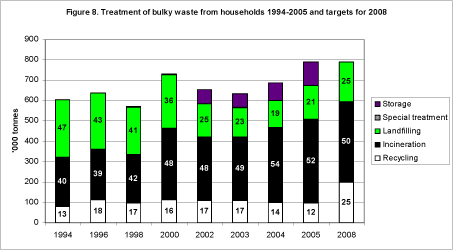
Source: same as Tables 1 and 2. Note that arisings in 2008 have been set to correspond to arisings in 2005. The figures are not projections of developments in waste arisings.
In 2005, 52 per cent of bulky waste was incinerated, the rate for landfilling was 21 per cent, and the rate for recycling 12 per cent. The remaining 15 per cent, however, was led to temporary storage; i.e. temporary landfilling of waste suitable for incineration. This means that the waste is stored until it can be incinerated for the purpose of energy/heat generation[14]. Therefore, the real incineration rate for bulky waste is higher than 52 per cent. At the same time, the figures show that the amount of waste led to landfills has gone down considerably since 1994.
The target of a maximum landfilling rate of 25 per cent has thus been met. However, too much bulky waste is still being incinerated and not enough is being recycled.
If targets for recycling in 2008 are to be met, considerable efforts are required to separate and collect more of the different waste fractions in bulky waste. A number of initiatives covering e.g. cardboard, waste electrical and electronic equipment have been, or are in the process of being, implemented.

Source: same as Tables 1 and 2. Note that arisings in 2008 have been set to correspond to arisings in 2005. The figures are not projections of developments in waste arisings.
Storage means that the waste in question has been assigned to temporary storage by local authorities (the local council), cf. section 37(3) of the Statutory Order on Waste. Denmark has excess incineration capacity, but storage can be due to e.g. repairs or shut down of operations at plants.
5.1.4 Garden waste
The amount of garden waste collected from households in 2005 came to 563,000 tonnes. This is an increase of 63.000 tonnes from 2004.
Throughout the 1990s the amount of garden waste increased steadily. From 1994 to 2005 there has thus been a 96 per cent increase.
This increase does not reflect a real increase in garden waste. It is rather the result of increasing opportunities for householders to dispose of garden waste at municipal waste treatment plants at the expense of home-composting. This means larger waste volumes to be treated in the municipal waste treatment system.
Treatment of garden waste is presented in Figure 9. In 2005, 99 per cent of garden waste was recycled, and around 1 per cent was landfilled.
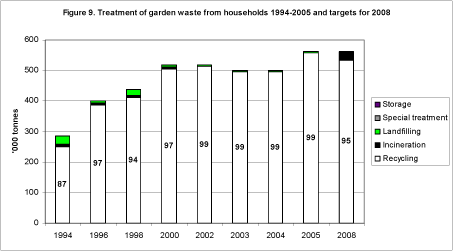
Source: same as Tables 1 and 2. Note that arisings in 2008 have been set to correspond to arisings in 2005. The figures are not projections of developments in waste arisings.

Source: same as Tables 1 and 2. Note that arisings in 2008 have been set to correspond to arisings in 2005. The figures are not projections of developments in waste arisings.
So, the targets for recycling and incineration of garden waste from households have been met by a good margin. Estimates indicate that it is impossible to increase the recycling rate any further.
5.2 Waste from the service sector
Waste from the service sector[15] amounted to 1,841,000 tonnes in 2005. This is up by 8,000 tonnes, or about the same as in 2004. As mentioned in Chapter 1, there has been a dramatic increase in waste arisings from the service sector since 2001 and the increase should therefore be regarded with some caution. However, the waste arisings appear to have stabilised over recent years.
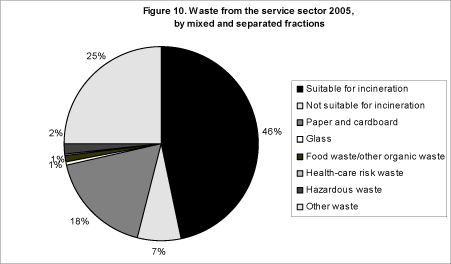
Source: ISAG reports 2005. The key is listed clockwise beginning at "12 o'clock".
Waste from the service sector is analysed by mixed and separated fractions in Figure 10. There is no great change in the percentage distribution of fractions from 2004 to 2005. Changes are between 0 and 1 per cent. Where waste suitable for incineration has dropped by 1 per cent, paper and cardboard has gone up by 1 per cent. For the remaining waste there have not been any changes. Waste suitable for incineration, paper and cardboard, and other waste are the three largest waste fractions from the service sector with 46 per cent, 18 per cent, and 25 per cent respectively.

Source: same as Tables 1 and 2. Note that arisings in 2008 have been set to correspond to arisings in 2005. The figures are not projections of developments in waste arisings.
Storage means that the waste in question has been assigned to temporary storage by local authorities (the local council), cf. section 37(3) of the Statutory Order on Waste. Denmark has excess incineration capacity, but storage can be due to e.g. repairs or shut down of operations at installations.
Table 26 shows the development in waste generation from the service sector in the period 2004 to 2005, analysed by fractions. It is apparent that most of the increase in the amount of waste from the service sector is to be found in the fractions various non-combustible and paper and cardboard. On the other hand, the fraction bottles and glass has gone down by as much as 29 per cent.

Source: ISAG 2004 and 2005.
Of the 1,841,000 tonnes of waste which the service sector generated in 2005, 45 per cent was recycled, another 45 per cent was incinerated, while 8 per cent was landfilled and 1 per cent placed in temporary storage, cf. Figure 11. The amount of waste that was recycled has thus gone up some, while the amount that is led to incineration has gone down compared to 2004. The waste put in temporary storage will be incinerated when incineration capacity becomes available[16]. In other words, the incineration rate is actually higher than the 45 per cent. Figure 11 shows that a still greater proportion of waste from the service sector is being recycled. This means there has been a diversion of waste volumes from incineration to recycling.
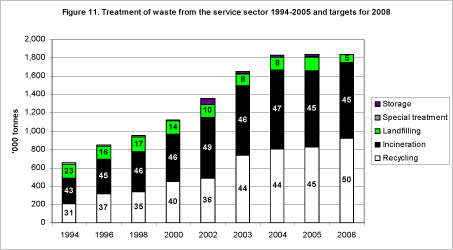
Source: same as Tables 1 and 2. Note that arisings in 2008 have been set to correspond to arisings in 2005. The figures are not projections of developments in waste arisings.
As stressed in Chapter 1, the increase in waste arisings from the service sector from 2001 should be regarded with some caution.
In relation to the targets for treatment in 2008 set out in Waste Strategy 2005-2008, too little waste from the service sector was still recycled and too much landfilled in 2005. If the 2008 targets are to be met, separation and collection of waste must be improved so that a larger proportion of recyclable materials can be recycled, and so that environmentally harmful waste types can be separated and treated separately.
5.3 Waste from industry
Waste generation from industry amounted to 1,855,000 tonnes in 2005, which is the same as in 2004. As mentioned in Chapter 1, since 2001 there has been a drop in the amount of waste from industry. However, the amount seems to have stabilised over recent years.
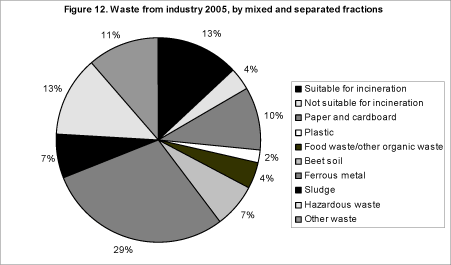
Source: ISAG reports 2005. The key is listed clockwise beginning at "12 o'clock".
Figure 12 shows a breakdown of waste from industry by mixed and separated fractions. As can be seen, ferrous metal is by far the largest single fraction, followed by the mixed fraction waste suitable for incineration, hazardous waste and other waste.
The individual fractions' percentage shares of total industrial waste are more or less unchanged from 2004. The greatest change is in ferrous metal which increased from 25 per cent in 2004 to 29 per cent in 2005, whereas the amount of beet soil and waste not suitable for incineration went down by 3 per cent. The remaining fractions show changes within 0-2 percentage points.
Table 27 shows the development in waste generation by industry in the period 2004 to 2005, analysed by fractions. As can be seen, the amount of paper and cardboard has gone up 27 per cent, while ferrous metal has gone up 18 per cent. Various non-combustible, on the other hand, has gone down 45 per cent and beet soil 34 per cent.
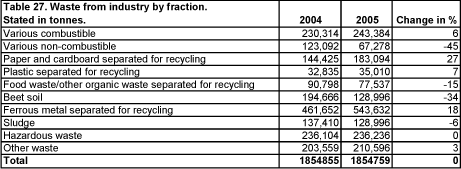
Source: ISAG 2004 and 2005.
Treatment of waste from industry is shown in Figure 13. In 2005, 65 per cent of the waste from this sector was recycled.
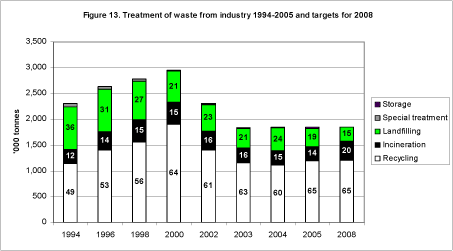
Source: same as Tables 1 and 2. Note that arisings in 2008 have been set to correspond to arisings in 2005. The figures are not projections of developments in waste arisings.
As stressed in Chapter 1, the fall in waste arisings from industry from 2001 should be regarded with some caution.

Source: same as Tables 1 and 2. Note that arisings in 2008 have been set to correspond to arisings in 2005. The figures are not projections of developments in waste arisings.
Storage means that the waste in question has been assigned to temporary storage by local authorities (the local council), cf. section 37(3) of the Statutory Order on Waste. Denmark has excess incineration capacity, but storage can be due to e.g. repairs or shut down of operations at installations.
The proportion of industrial waste led to incineration in 2005 was 14 per cent. The landfilling rate dropped by 5 per cent from 2004 to 2005, ending at 19 per cent in 2005.
This means that the 2008 target of landfilling a maximum of 15 per cent of industrial waste has not been met. Denmark still landfills far too much industrial waste. Even if the rate of landfilling has taken a positive direction since 1994, there is still some way to go before the 2008 target for this treatment option is met, cf. Figure 13.
The volumes and composition of waste from industry vary according to the sector generating the waste, as well as size and number of enterprises. Possibilities of waste prevention or recycling will therefore differ from one waste fraction and sector to another.
In order to meet the targets in the Waste Strategy 2005-2008, the Danish EPA has selected a number of waste types from industry to come into focus. These waste types include waste from foundries and shredder waste, which are to be diverted from landfilling to recycling whenever environmentally and economically efficient.
With the latest amendment to the Statutory Order on Waste the Danish EPA has implemented a number of changes to the ISAG system, so that since 2001 it has been possible to analyse waste from industry between eleven different sectors.
Waste generation in industry stated by sector and treatment option can be seen in Table 29.
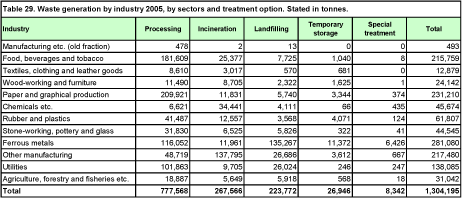
Source: ISAG reports 2005. The Table does not cover beet soil and ferrous metal reported by large scrap dealers.
As apparent from the table, food, beverages, and tobacco; the ferrous metal industry; other manufacturing; the paper and graphical production industry; and utilities contributed around 70 per cent of waste from industry in 2005. The amount of waste from manufacturing etc. was 493 tonnes. In 2002, waste generation from this source amounted to 238,815 tonnes, which means that reporting enterprises have improved their reporting on the new commercial sources (cf. as the commercial source manufacturing industries etc. was discontinued in 2001).
5.4 Waste from building and construction activities
The generation of waste by the building and construction sector increased from 2004 to 2005. Volumes of construction and demolition waste amounted to 5,270,000 tonnes in 2005, which is 775,000 tonnes, or 17 per cent, more than in 2004. This increase can be attributed e.g. to greater activity in the building and construction sector in general.
As is apparent from Table 30, which shows the development in waste arisings in the building and construction sector, the greatest increase in total arisings stems from the fraction soil and stone, which increased by 565,000 tonnes or 41 per cent. Also in the fraction various non-combustible and other waste, the increase is substantial, at 22 and 21 per cent respectively. There is an 11-per-cent drop in arisings of other construction/demolition waste. By far the major part, or 94 per cent, of waste generated by the building and construction sector is recycled.

Source: ISAG 2004 and 2005.
Figure 14 shows that the rate of waste which is recycled in 2005 remained the same as 2004. This also applies to incineration and landfilling.
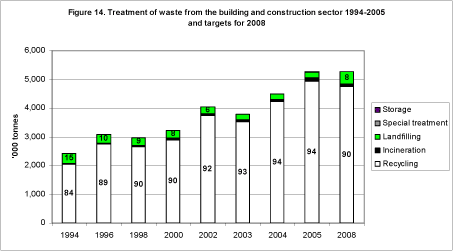
Source: same as Tables 1 and 2. Note that arisings in 2008 have been set to correspond to arisings in 2005. The figures are not projections of developments in waste arisings.
As the figure also shows the recycling rate for construction and demolition waste increased by 10 per cent in the period 1994 to 2005. At the same time the landfilling rate went down by 11 per cent. The figure also shows that the distribution of waste between the different treatment options has been in line with targets for 2008 since 2000.

Source: same as Tables 1 and 2. Note that arisings in 2008 have been set to correspond to arisings in 2005. The figures are not projections of developments in waste arisings.
Storage means that the waste in question has been assigned to temporary storage by local authorities (the local council), cf. section 37(3) of the Statutory Order on Waste. Denmark has excess incineration capacity, but storage can be due to e.g. repairs or shut down of operations at installations.
The high recycling rate for construction and demolition waste is due partly to the fact that recycled waste, unlike landfilled or incinerated waste, is exempt from taxation, and partly due to a 1995 departmental circular on municipal regulation concerning the separation of construction and demolition waste intended for recycling[17]. In addition, the Ministry of the Environment and the Danish Contractors' Association have entered an agreement on selective demolition of buildings.
Figure 15 shows construction and demolition waste analysed by mixed and separated fractions for 2005. It can be seen that the bulk of building waste consists of concrete, asphalt, and soil and stone.
Relative to 2004, the share of soil and stone has gone up, from 31 per cent in 2003 to 37 per cent in 2005. This is due to greater activity in the building and construction sector, resulting in more soil being sent to some of the treatment plants. Otherwise, there have not been great changes in the spread between fractions from 2004 to 2005. Changes are between 0 and 3 percentage points.
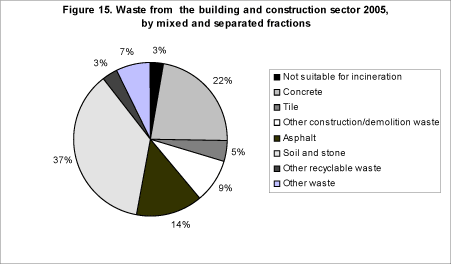
Source: ISAG reports 2005. The key is listed clockwise beginning at "12 o'clock".
A large part of the waste from the building and construction sector is reprocessed at mobile crushing plants which are used for different assignments at different locations throughout Denmark.
The owner of the mobile crushing plant is responsible for the ISAG reports to the Danish EPA, but sometimes the entrepreneur also reports the waste. The Danish EPA is very much aware of this possible source of double reporting, and great efforts are being made, in co-operation with the providers of the reports, to ensure quality control and avoid double reporting.
5.5 Residues from coal-fired power plants
The generation of residues at coal-fired power plants varies from one year to the next due to variations in Danish imports/exports of electricity to and from Sweden and Norway. Imports/exports of electricity to and from Sweden and Norway depend largely on precipitation in these countries - if there is much precipitation, much electricity is generated from hydropower in Sweden and Norway, and Danish exports will be correspondingly lower.
For example, in 1996 exports of power were particularly high, which is reflected in amounts of residues in this year, cf. Figure 16. In 2000, there was high precipitation in Sweden, which resulted in so much cheap hydroelectricity on the market that power stations in both Denmark and Norway had to cease operation temporarily.
Amounts of residues have decreased steadily since 1996, but show an increase from 2002 to 2003. This fall stems for a great part from the fact that, over time, coal has been supplanted by natural gas and renewables, including biofuels. Energy statistics[18] reflect that a still smaller share of electricity generation is based on coal. Also in future, the phase-out of coal will result in a decrease in residues from coal-based energy generation, whereas there will be an increase in fly ash and bottom ash from bio-fuels.
Residues from coal-fired power plants amounted to around 1,081,000 tonnes in 2005, which is a fall of 8 per cent from 2004. As Figure 16 shows, 97 per cent of residues was recycled and 3 per cent was landfilled. The fall in the amount of residues is due e.g. to falling exports of electricity to, for example, Sweden, Norway, and Germany. Thus, net exports fell by 148 per cent from 2004 to 2005.[19]
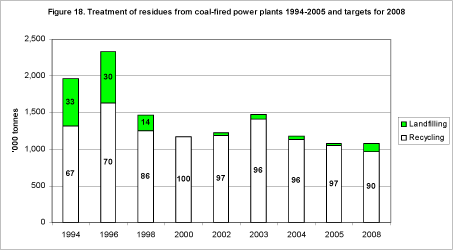
Source: same as Tables 1 and 2. Note that arisings in 2008 have been set to correspond to arisings in 2005. The figures are not projections of developments in waste arisings.

Source: same as Tables 1 and 2. Note that arisings in 2008 have been set to correspond to arisings in 2005. The figures are not projections of developments in waste arisings.
The recovery of residues in 2005 is stated in more detail in Table 33. More than 90 per cent of residues is used as raw materials in industrial manufacture of, for example, cement, concrete and plasterboard, whereas the remaining part is primarily used as backfilling, either in accordance with the provisions of Statutory Order no. 655 of 27 June 2001 from the Ministry of the Environment, or as backfilling with special approval under the Danish Environmental Protection Act.
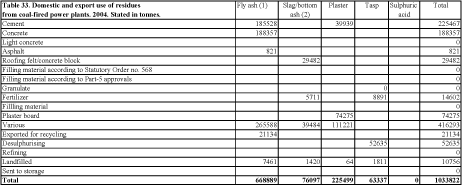
Source: Reports from Elsam and Energi E2.
5.6 Sludge from municipal wastewater treatment plants
The statement for 2005 from municipal wastewater treatment plants of amounts of sludge applied to farmland and incineration of sludge at sludge incineration plants is not yet available due to a reorganisation of the electronic reporting system.[20] For recycling and incineration, 2002 figures from the Danish EPA's sludge statistics have been used. [21]
As mentioned in Chapter 1, it was decided to state amounts of sludge for mineralisation with a dry matter content of 20 per cent, so that sludge for mineralisation would be stated with the same dry matter content as other sludge. In the treatment in sludge mineralisation plants (long-term storage) sludge is reported with around 0.5 - 1 per cent dry matter content, whereas alternatives typically contain 20 per cent.
Treatment of sludge from municipal wastewater treatment plants is shown in Figure 17. According to the Figure, 56 per cent of sludge is recycled, 43 per cent is incinerated, and 2 per cent is landfilled.
The figures for recycling include 45,600 tonnes of sludge with a dry matter content of 20 per cent, corresponding to 607,922 tonnes sludge in wet weight, which are being treated in long-term storage with the objective of further mineralisation. This amount has been included in the amounts for recycling because the sludge will be recycled after a number of years in storage.
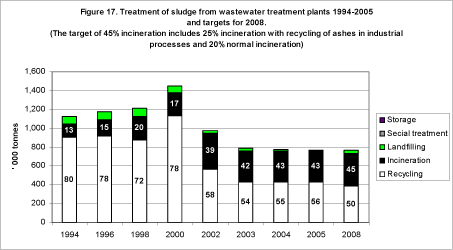
Source: same as Tables 1 and 2. Note that arisings in 2008 have been set to correspond to arisings in 2005. The figures are not projections of developments in waste arisings. The figure shown for 2005 is based on 2002 figures. The method of calculation of sludge for mineralisation has been changed with effect from 2001. The figures for recycling include 45,600 tonnes of sludge with a dry matter content of 20 per cent, corresponding to 607,922 tonnes when stated in wet weight. Long-term storage and incineration amounts include 221,730 tonnes for other uses (Carbogrit and production of concrete).

Source: same as Tables 1 and 2. Note that arisings in 2008 have been set to correspond to arisings in 2005. The figures are not projections of developments in waste arisings. The figures for recycling 2003 to 2005 are 2002 figures.
Sewage sludge is mainly recovered as fertiliser on farmland. In recent years, the requirements regarding contents of certain organic and chemical substances in sludge applied to farmland have been made stricter. In the short term, the rate of recycling is therefore expected to decrease. In the long term, it is expected the general phase-out policy for xenobiotic substances will improve the quality of sludge further.
Finally, it appears that alternative methods of sludge recovery are being discovered to an ever greater extent. After sludge incineration, the inorganic residue is recovered in the production of e.g. sand blasting agents, or cement. Sludge recovered by such alternative methods in 2002 amounted to around 220,000 tonnes[22]. In Figure 17, this amount has been included in incineration because it is recovery, not recycling.
5.7 Residues from waste incineration plants
Figure 18 shows amounts of residues (slag, fly ash, and flue-gas cleaning products) from waste incineration plants 1994 to 2005 in tonnes, including treatment option.
Residues from waste incineration plants have not been included in calculations of total waste generation, since the waste would then be counted twice in the statistics. However, residues are a large waste fraction and to secure adequate capacity for their treatment, a calculation of amounts is required.
By far the major part of residues is recycled. The recycling rate was 99 per cent in 2005, which is 1 percentage point up from 2004. Residues, however, are not recyclable when containing large quantities of heavy metals, which may leach into the soil, groundwater and surface water. In such cases landfilling is required.
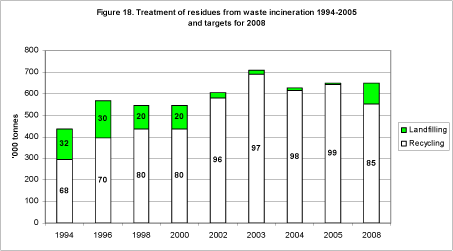
Source: same as Tables 1 and 2. Note that arisings in 2008 have been set to correspond to arisings in 2005. The figures are not projections of developments in waste arisings.
Note that Figure 18 is not comparable with Table 33 and Figure 19, because Figure 18 is exclusive of exported residues.

Source: same as Tables 1 and 2. Note that arisings in 2008 have been set to correspond to arisings in 2005. The figures are not projections of developments in waste arisings.
Contaminated fractions such as PVC, impregnated wood, and electric and electronic products, are not to be incinerated. This means that contents of heavy metals in slag will be reduced significantly. However, requirements for recycling of slag were tightened in 2000 to take account of the groundwater. The 2008 target of 85 per cent recycling has already been met.
Table 36 shows the treatment of residues from waste incineration. Naturally, amounts of residues depend on the amount of waste incinerated. Slag and flue-gas cleaning products typically comprise around 20 per cent and 5 per cent, respectively, of the waste amount led to incineration.

Source: Calculations are based on ISAG reports and registrations under the EU regulation on shipments of waste. Note that Table 36 and Figure 18 are not comparable. This is because Figure 18 does not include exports.
Table 36 shows that residues from waste incineration amounted to around 678,000 tonnes in 2005. This is 27,000 tonnes more than in 2004. Out of the 678,000 tonnes of residues removed from waste incineration plants, around 198,000 tonnes were landfilled, while around 588,000 tonnes were recycled. This means that, in reality, the stored amounts of fly ash and flue-gas cleaning products have been reduced by about 108,000 tonnes.
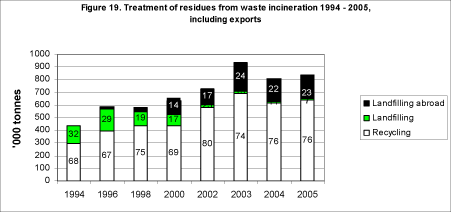
Source: ISAG reports and registrations under the EU regulation on shipments of waste.
As is evident in Figure 19, the amount of residues exported for landfilling abroad has been increasing since 1996. The amount of residues exported for landfilling went up from 21,000 tonnes in 1996 to 191,000 tonnes in 2005. Relative to 2004, there has been an increase of 10,000 tonnes in landfilled volumes. The main part of these was excavated from landfills in Denmark, as can be seen from Table 36.
From 1996 to 2005, amounts of landfilled residues have gone up by about 3 per cent and recycling has increased by 54 per cent.
6 Incineration plants and landfills
6.1 Incineration plants
In 2005, total waste incineration capacity was around 3,380,000 tonnes, distributed between 29 plants, cf. Table 37. This is an increase in capacity of 682,000 tonnes compared to the 1999 capacity.
In the early 1990s, an extensive conversion of waste incineration plants from heating generation to combined heat and power took place. In this connection, capacity adjustments were effected in relation to expected waste volumes for incineration in the future.
As a result of the ban on landfilling of combustible waste that took effect on 1 January 1997, there is now increasing pressure on incineration capacity. Volumes of non-recyclable waste suitable for incineration will be surveyed regularly in order to ensure the necessary incineration capacity.
| Table 37. Number of incineration plants and available incineration capacity in: | 1989 | 1993 | 1994/95 | 1996 | 1999 | 2003 | 2005 |
| Number of incineration plants | 38 | 31 | 31 | 31 | 31 | 32 | 29 |
| Theoretic capacity, '000 tonnes | 2164 | 2329 | DH: 1217 CHP: 1315 |
DH: 1060 CHP: 1413 |
DH: 915 CHP: 1783 |
3389 | 3380 |
| Nominal capacity, tonnes/hour | 313 | 335 | DH: 174 CHP: 188 |
DH: 171 CHP: 194 |
DH: 166 CHP: 271 |
Source: Rambøll & Hannemann 1990: Analysis of data for energy plants based on waste, for the Danish EPA and the Danish Energy Authority. The Danish EPA and the Danish Energy Authority 1994: Waste resources for waste incineration 1993 and 2000. The Danish EPA and the Danish Energy Authority 1997: Waste for incineration year 2000. The Danish EPA and the Danish Energy Authority 2001: Waste incineration in 2004 and 2008. Volumes and capacities. Environmental Review No. 11, 2001.
Figures for 1989 and 1995 are calculated on the basis of nominal capacity at 7,000 hours/year. The figures for 1996 and 199 are based on the actual hours of operation of the plants. District heating capacity (DH) may be subject to restrictions under the Danish Act on Heating Supply. CPH = combined power and heating. In figures for 1999 the nominal capacity includes plants erected in 1999. This gives a larger nominal capacity as furnaces were not in full operation in 1999. The figure for 2003 was calculated by the Danish EPA.
6.2 Landfills
In the Statutory Order on landfills[23], a landfill is defined as waste disposal facilities on land for the landfill of waste covered by K1b, K3a, K3b or K3c in Annex 1 of the Statutory Order on Approval of Listed Activities[24]. This definition includes landfills (including controlled landfills), inert waste landfills and mono-landfills.
Today, there are 134 landfill facilities in Denmark with an environmental approval, according to a questionnaire study conducted by the Danish EPA in February/March 2001, cf. Table 38.
Of these, 100 facilities are owned by public authorities, whereas 34 are under private ownership. The 100 public facilities cover 51 landfills, 25 inert waste landfills, and 24 mono-landfills.
The privately owned facilities cover 3 landfills, 10 inert waste landfills and 21 mono-landfills.
![]()
Source: Danish EPA: Working Report No. 54, Landfill Capacity 1992. Danish EPA 1997: Working Report no. 33, Landfills in Denmark, plus own calculations. Questionnaire study carried out by the Danish EPA in February/March 2001.
7 Economic development and projection of waste arisings for incineration
- 7.1 Waste arisings and economic development
- 7.2 Projection of waste arisings
- 7.3 Baseline projection of waste arisings 1994 to 2020
7.1 Waste arisings and economic development
Waste generation is a result of all activities in society. The challenge is to decouple the increase in waste volumes from general economic growth. Responsibility for solving the problem of increasing volumes of waste is shared by all sectors of society. The initial goal is thus to ensure that the increase in waste generation does not occur at the same rate as the increase in economic development.
Figure 20 shows that total waste arisings increased faster than economic growth in the period 1995 to 1996. This was followed by a decline in arisings, and yet another increase during 1999 to 2000. Danish waste arisings remained fairly stable in the period 2000 to 2003, but increased dramatically in 2004 and 2005, e.g. due to increased amounts of construction and demolition waste.
If total waste generation is shown in proportion to gross domestic product (GDP), it provides an indication of the waste intensity in society.
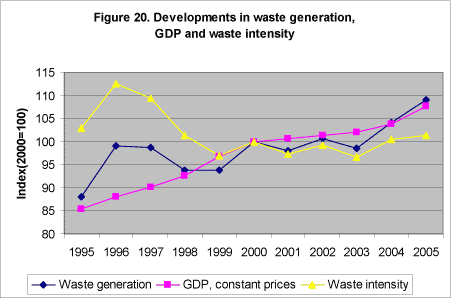
The figure shows the relative development of gross domestic product in constant prices[25] (GDP) and waste production and waste intensity, illustrating the ratio between the relative development of waste production and the relative development of GDP. As can be seen from the figure, waste intensity declined until 1999 (decoupling) and has subsequently remained relatively constant, apart from slight increases in 2004 and 2005. This means that, by and large, the growth in waste arisings has corresponded to the growth in GDP since 1999, however with a slight upward trend in waste intensity. This development, therefore, does not indicate a decoupling; rather it indicates a fairly stable relationship between growth in waste volumes and economic growth, stated as GDP.
Since waste arisings in a number of sectors are increasing, it is important to continue to work towards reducing the volumes of waste. Forecasts for future waste generation show that waste volumes will increase, unless active efforts are made to reduce them. This can be seen, for example, in the European Environment Agency's report, "Environment in EU at the turn of the century".
As the basis for future waste planning, it is therefore necessary to have an idea of the increase in waste arisings in future. A model projection of waste arisings up to 2020 is presented in the following.
7.2 Projection of waste arisings
The following is a baseline projection of waste arisings up to 2020. The so-called FRIDA model has been used for this projection[26].
The projection is based on the Ministry of Finance’s projection of economic growth Finansredegørelse 2006 (budget statement 2006), the Danish Energy Authority's most recent projection of coal consumption from 2005[27], and waste data from ISAG for the period 1994 to 2004.
FRIDA describes the trend in waste arisings for the individual fractions and sources in ISAG in relation to economic development. FRIDA is therefore a hybrid of a scenario model and an econometric model. For the large waste streams, the relationship between economic development and developments in waste arisings is identified by performing an econometric analysis of the period 1994 to 2003. This means that for these waste streams, an analysis is performed which determines the connection between trends in waste arisings and economic activity in society. Subsequently, the development in waste arisings is projected on the basis of the assumption that the relationship between the economy and waste arisings will be remain the same in future as in the period 1994 to 2003. The analysis thus takes into account the fact that production technologies may have changed over time, as may the relationship between consumption and production. Other factors may also be of significance. The large waste fractions include:
- Various combustible
- Various non-combustible
- Paper and cardboard
- Organic waste
- Ferrous metal
- Construction waste
For the other waste streams, developments are described in a scenario model which assumes constant waste coefficients. That is, the model assumes a constant relationship between waste arisings and economic development.
The FRIDA model is used to project waste arisings up to 2020.
7.3 Baseline projection of waste arisings 1994 to 2020
The waste prognosis is based on the Ministry of Finance’s ADAM projection from 2006. In the period 2004 to 2020, total production (in constant prices) is expected to increase by about 29 per cent, and private consumption is expected to increase by about 37 per cent. Figures on coal consumption by industry and power plants from the Energy Authority are on the assumption that consumption by power plants will drop towards 2020, while consumption by industry will go up.
Actual waste arisings increased from 1994 to 2004 by around 20 per cent (see Table 1). A projection of primary waste amounts 2004 to 2020 gives an increase in arisings of around 14 per cent, from around 13.4 million tonnes of waste in 2004 to an overall waste volume of around 15.3 million tonnes in 2020, cf. Figure 21[28].
A comparison of the increase in waste arisings with the increase in production and consumption respectively gives a projection in which waste arisings will increase less than the economic growth. One important reason for the smaller increase in waste arisings is falling coal consumption by power plants, which means that the amount of slag and ashes etc. from the power plants is at least expected to halve.
Figure 21. Trends in primary waste arisings
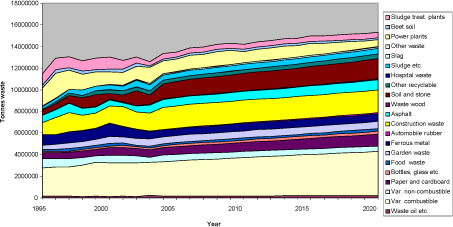
As can be seen from Figure 21, the baseline projection shows a significant increase in the amounts of various combustible, paper and cardboard, construction and demolition waste and soil and stone. The most important reason for this increase can primarily be traced to the projection of private consumption, which is expected to increase by around 37 per cent up to 2020. In contrast, a drop in the amount of non-combustible waste from power plants is anticipated.
About 50 per cent of combustible waste originates from households. This rate has been decreasing over recent years, whereas there has been a dramatic increase in the amount of combustible waste from the service sector. The amount of combustible waste from industry has shown a downward trend. However, there is uncertainty as to the development of waste arisings from industry and the service sector in particular (cf. Chapter 1). In the projection it is therefore assumed that the increase in service-sector waste volumes is unlikely to continue at the same pace, but that it will increase in step with economic growth. Amounts of waste from industry are assumed to continue in step with economic growth. The amount of combustible waste from households, on the other hand, is not assumed to increase in step with economic growth; here a decoupling from the economic development is expected.
From 1994 to 2004 the total amount of collected waste paper and cardboard will increase by about 92 per cent, amongst other things due to expansion of the collection scheme (see Table 5). It is however assumed that the consumption of paper and cardboard by households, the service sector and industry will follow the economic development.
Amounts of construction and demolition waste have fluctuated over time. From 1994 to 2004, amounts increased by 85 per cent, however (see Table 3). As can be seen from Figure 21, construction and demolition waste volumes are expected to increase up to 2020. The main reason for this increase is that building and construction activities are assumed to follow the economic development. With expected greater consumption, construction and demolition waste must be expected to increase as well.
The amount of various non-combustible waste decreased significantly from 1994 to 2004. This is due e.g. to increased source separation and, consequently, an increased amount of waste being recycled. It is uncertain whether this trend will continue or whether there is actually a saturation point for how much can be separated for recycling etc. However, in the model this trend is assumed to continue up to 2020.
As can be seen from Figure 22, no great changes are expected in the amount of waste for recycling. Where about 65 per cent was recycled in 2004, it is expected that 65.5 per cent will be recycled in 2020. Where 26 per cent was incinerated in 2004, it is expected that about 28.3 per cent will be incinerated in 2020. The rate of waste led to landfill is expected to drop from 8 per cent in 2004 to 6.2 per cent in 2020.
Figure 22. Trends in the breakdown of treatment options
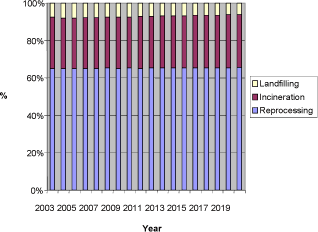
Annex 1. Tables of waste generation
Table 1. Waste generation in Denmark in 2003, 2004 and 2005, and targets for 2008, stated by source and treatment option. Stated in '000 tonnes and in per cent.
Source: ISAG reports, the Danish government's Waste Strategy 2005-2008, Danisco, the Association of Danish Recycling Industries and other large scrap dealers, reports to the Danish EPA on sludge applied to farmland etc. and incineration of sludge at sludge incineration plants (figures from 2001). Waste from wastewater treatment plants includes sand and screenings.
Table 2. Waste treatment in Denmark in 2003, 2004, and 2005 stated by waste type and treatment option. Stated in ‘000 tonnes and in per cent.
Source: ISAG reports, the Danish government's Waste Strategy 2005-2008, Danisco, the Association of Danish Recycling Industries and other large scrap dealers, reports to the Danish EPA on sludge applied to farmland etc. and incineration of sludge at sludge incineration plants (figures from 2001). Waste from wastewater treatment plants includes sand and screenings
Annex 2. Principles for distribution of waste received at recycling centres and transfer stations
Click here to see Annex 2 table
Appendix 3. Statement of organic waste for composting, wood chipping and biogasification
Wastes from the following plants have been included under the various categories:
Reprocessing of organic waste (53.00) from all sources into animal foodstuff.
PNA 83 ApS. DAKA
Reprocessing of organic domestic waste (53.00) from households (source 1) for composting.
Østdeponi Amba. I/S Amagerforbrænding. Fredericia Municipality. Fangel Miljø & Energiselskab amba. Klintholm I/S. Marius Pedersen Kolding. Solum. Køstrup Komposteringsanlæg.
Reprocessing of organic domestic waste (53.00) from households (source 1) for biogasification.
Hashøj Biogas. Grindsted Municipality. AFAV I/S. Solum.
Reprocessing of organic waste (53.00) from remaining sources for composting.
Østdeponi Amba. Renoflex. Klintholm I/S. Fredericia Municipality. Komtek Miljø A/S. Grindsted Municipality.
Reprocessing of organic waste (53.00) from remaining sources for biogasification.
Fangel Miljø og Energiselskab. Thorsø Miljø og Biogas. AFAV I/S. Hashøj Biogas.
Reprocessing of sludge (83.00) for composting.
RGS 90. Odense Magistrat. Affaldsselskab Vest. I/S Fællesforbrænding. BN Industrirenovation. Affaldsselskabet Vendsyssel Vest I/S. I/S Reno Syd. Komtek Miljø A/S. H.J. Hansen Genvinding A/S.
Reprocessing of sludge (83.00) for biogasification.
Linkogas. Lemvig Biogasanlæg. Hashøj Biogas. Aarhus Kommunale Værker.
Branches, leaves, grass (54.00) for composting/wood chipping.
All plants which have received fraction 54.00 for reprocessing.
Annex 4. Hazardous waste generation
[1] Statistical Ten-Year Review 2006. Statistics Denmark.
[2] Primarily, the fall in the number of plants/enterprises is due either to discontinuation or they have merged with other ISAG-reporting plants.
[3] Developments from 1994 to 2005 are described in more detail in section 1.5.
[4] Statistical Ten-Year Review 2006. Statistics Denmark.
[5] As of yet, there is no statement from the municipal wastewater treatment plants of the amounts of sludge applied to farmland or incinerated at sludge incineration plants in 2005. For recycling and incineration, the 2002 figures from the Danish EPA's sludge statistics have therefore been used, while for landfilling the 2005 figures from the ISAG have been used. See "Sewage sludge from municipal and private wastewater treatment plants in 2002". Environmental Review No. 5, 2004, Danish EPA.
[6] Preliminary figures from the Danish Energy Authority on energy generation and consumption, and CO2 emissions in 2004. Denmark's actual energy consumption of coal and coke was 184 PJ in 2004. In 2005, this figure has dropped to 156 PJ.
[7] The Danish Energy Authority's monthly electricity statistics.
[8] Exemption clause in Section 37(3), Danish Statutory Order on Waste (Statutory Order No. 619 of 27 June 2000).
[9] Note that domestic waste suitable for incineration must be assigned to incineration. However, for islands that are not connected by land to an incineration plant there is an exemption from this duty of assignment.
[10] Reporting of packaging waste to the EU.
[11] Statistics for recycling of packaging waste 2004. Environmental Project No. 1129, 2006.
[12] Statistics for recycling of packaging waste 2004. Environmental Project No. 1129, 2006.
[13] Council Regulation No. 259/93 on the supervision and control of shipments of waste within, into and out of the European Community
[14] Exemption clause in Section 37(3), Danish Statutory Order on Waste (Statutory Order No. 619 of 27 June 2000.
[15] The service sector covers the commercial source: institutions, trade and offices.
[16] Exemption clause in Section 37(3), Danish Statutory Order on Waste (Statutory Order No. 619 of 27 June 2000.
[17] Circular No. 94 of 21 June 1995.
[18] The latest Energy Statistics are found on www.ens.dk, the Danish Energy Authority's website.
[19] Danish Energy Authority Monthly Electricity Statistics. Available at www.ens.dk.
[20] According to the EU Directive on sludge, sludge has to be reported only every third year. Denmark will therefore be requesting data on sewage sludge from the municipalities only every third year.
[21] See "Sewage sludge from municipal and private wastewater treatment plants in 2002".Environmental Review No. 5, 2004, Danish EPA. Landfilling figures are from ISAG, figures for 2004. The statement for 2005 is not yet available.
[22] The statement for 2004 is not yet available. The figure "Other, etc." is from Annex 4.4 of the sludge statistics ("Sewage sludge from municipal and private wastewater treatment plants in 2002").
[23] Statutory Order no. 650 of 29 June 2001 on landfills.
[24] Statutory Order no. 652 of 3 July 2003 on approval of listed activities.
[25] Constant prices are prices for the year adjusted for inflation, and are thus an indicator of real growth.
[26] En model til FRemskrivning af ISAG DAta. FRIDA (FRIDA, a model for projection of ISAG), Working Report No.35, 2006, from the Danish EPA.
[27] Energy Strategy 2025, the Danish Ministry of Transport and Energy.
[28] Note that e.g. amounts of paper and cardboard are not an expression of the total potential of this fraction, but merely state the amount of paper and cardboard separated for recycling. The fraction combustible waste thus may also contain paper and cardboard and other recyclable fractions.
Version 1.0 September 2007, © Danish Environmental Protection Agency